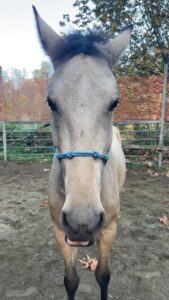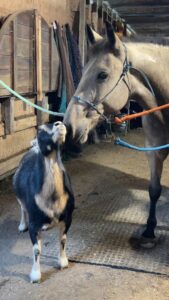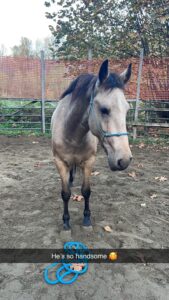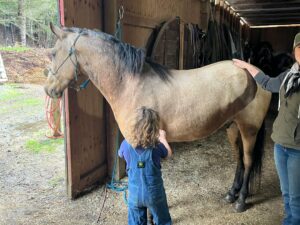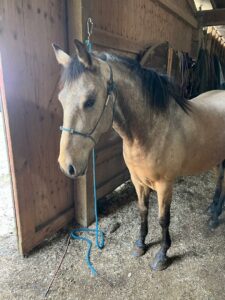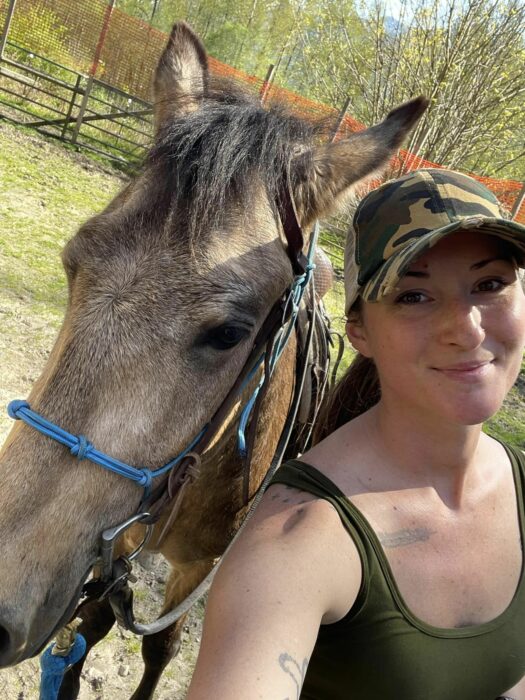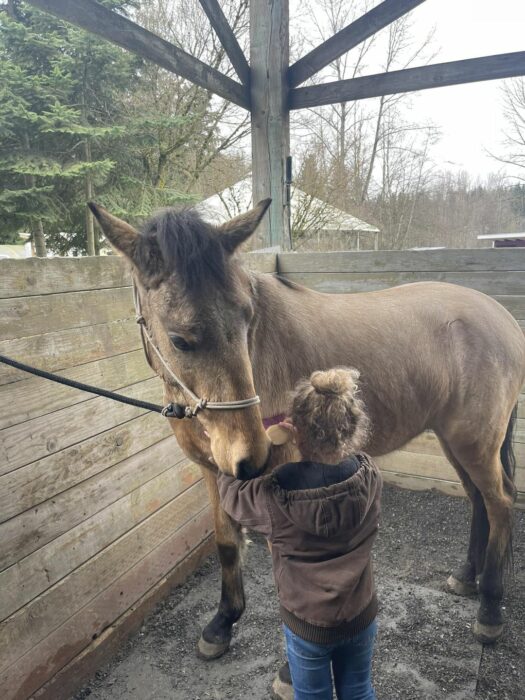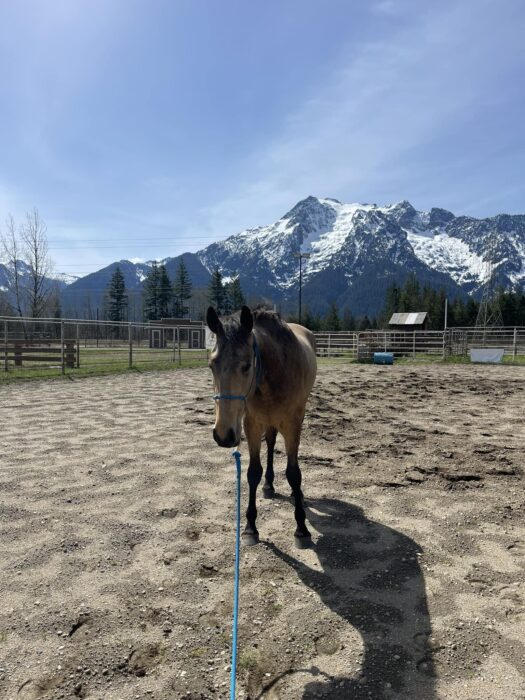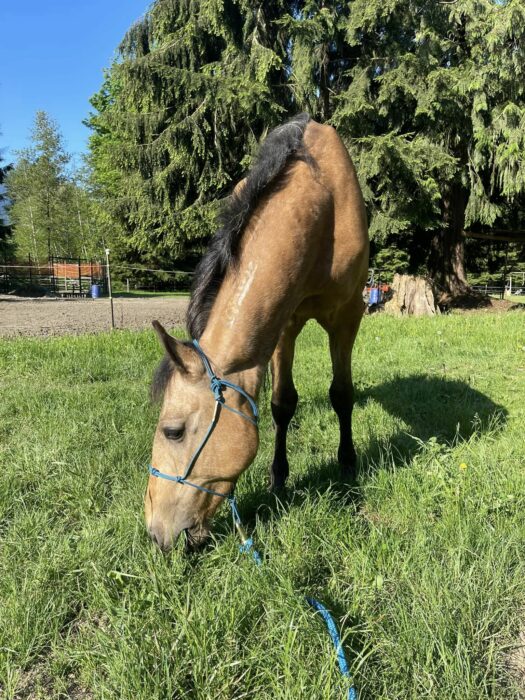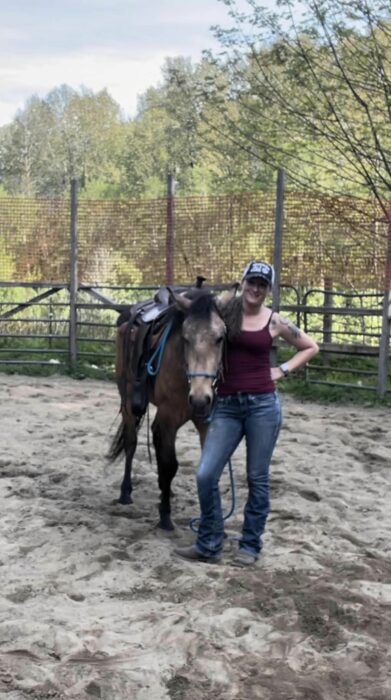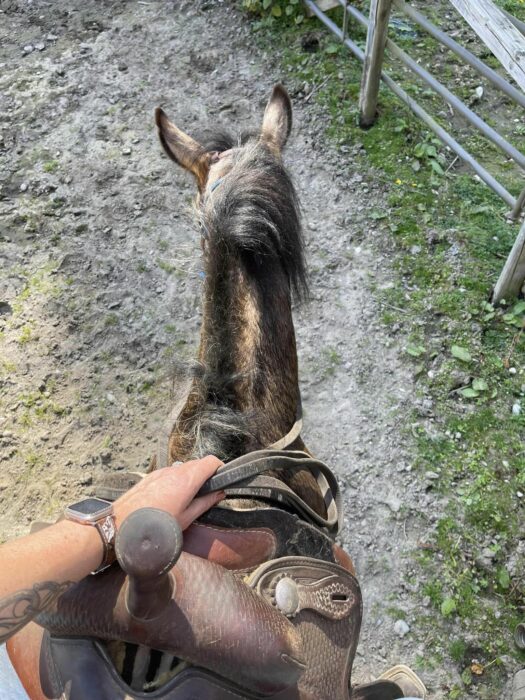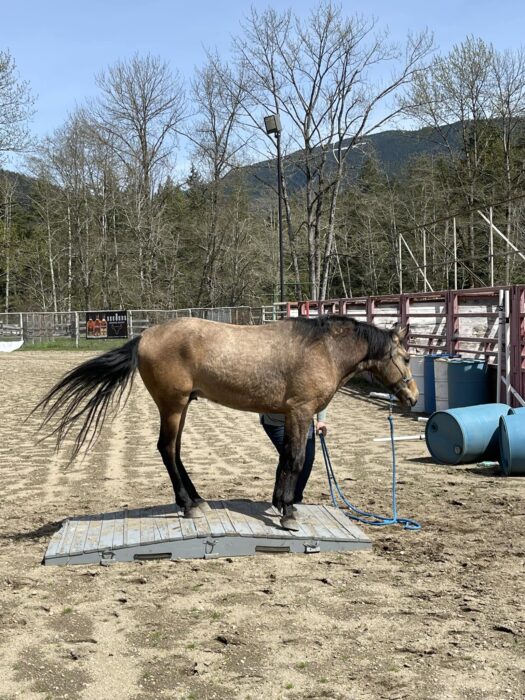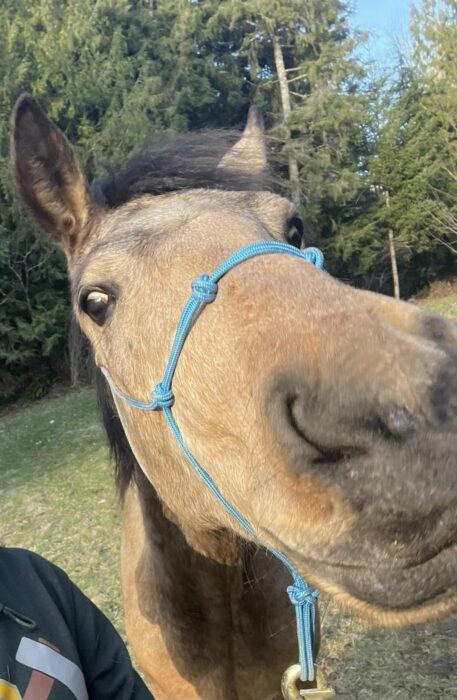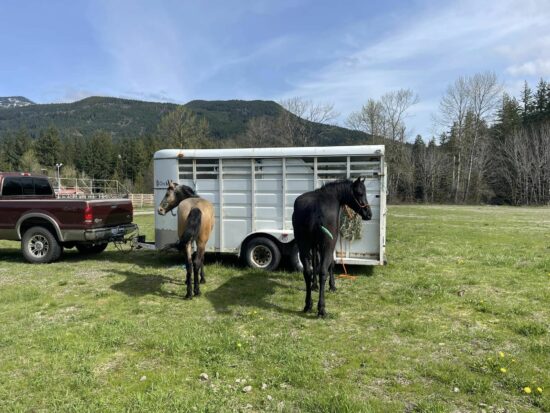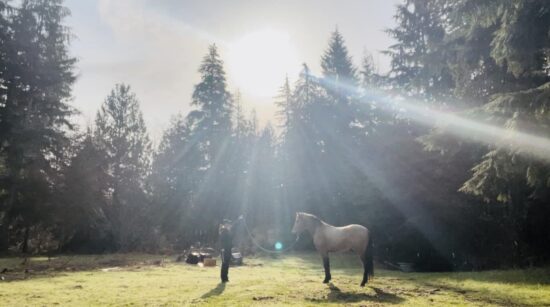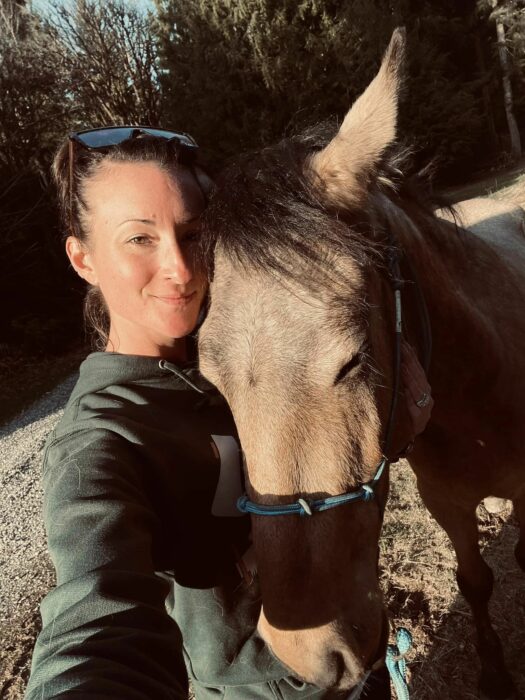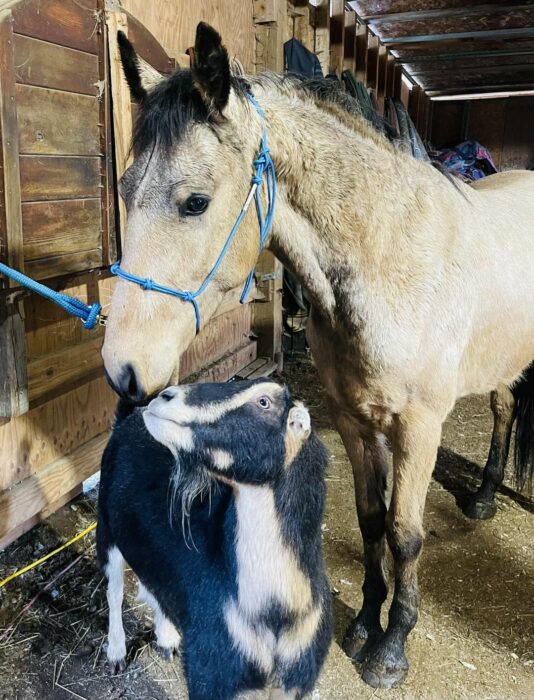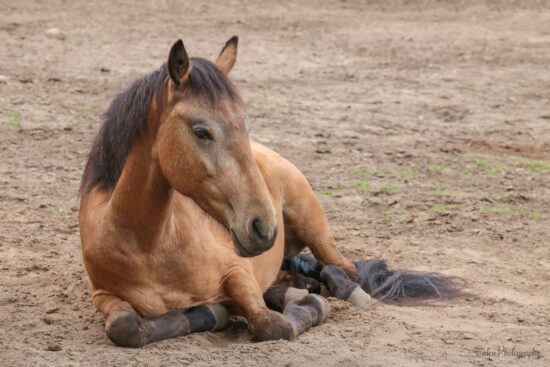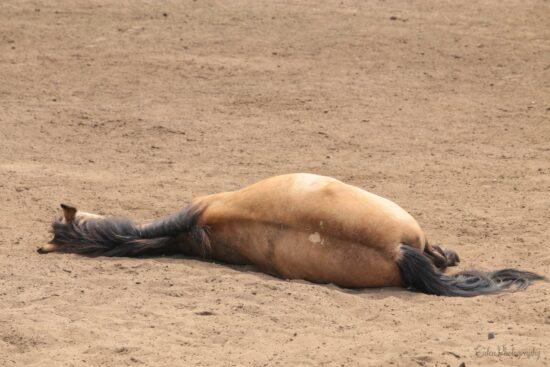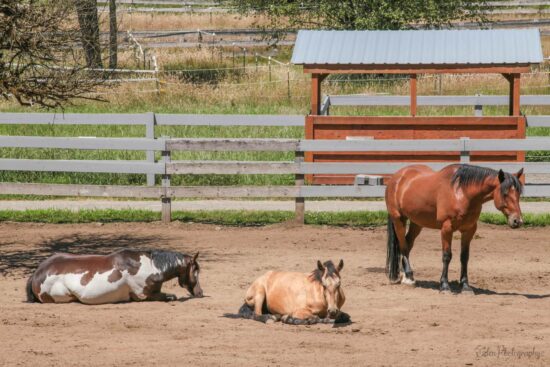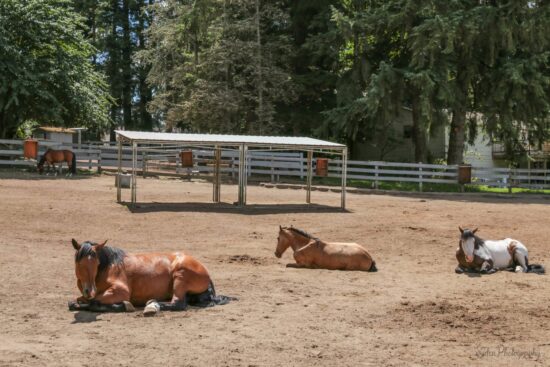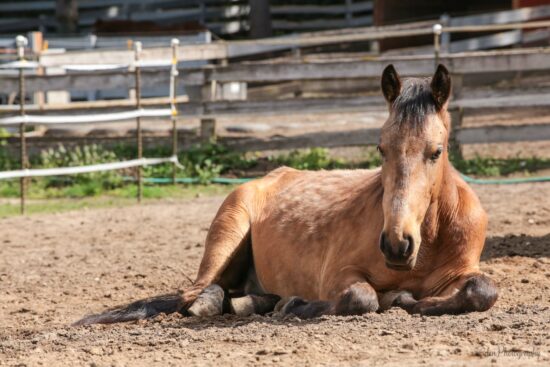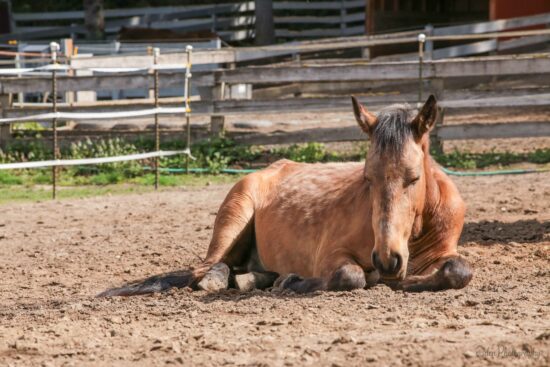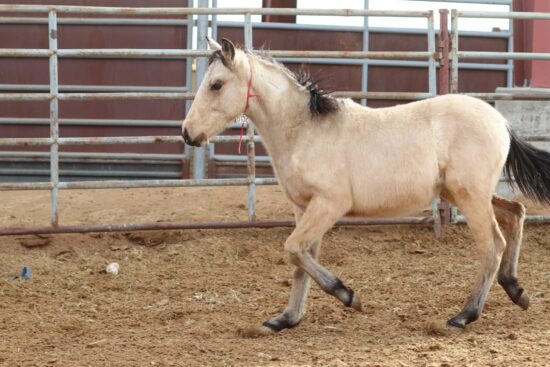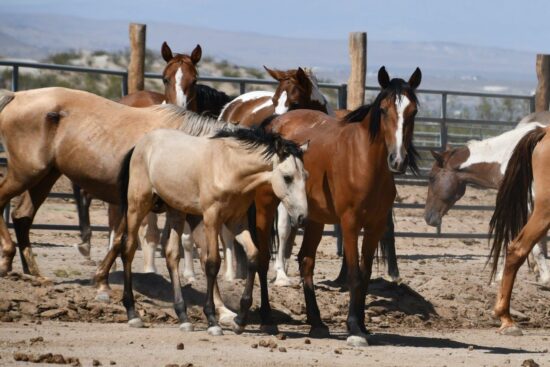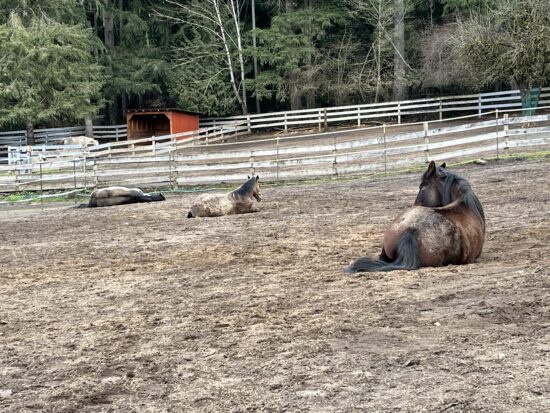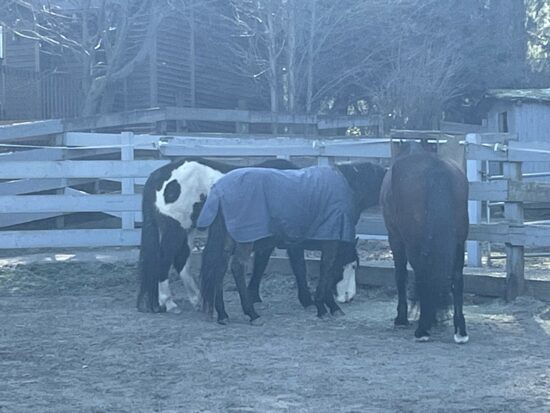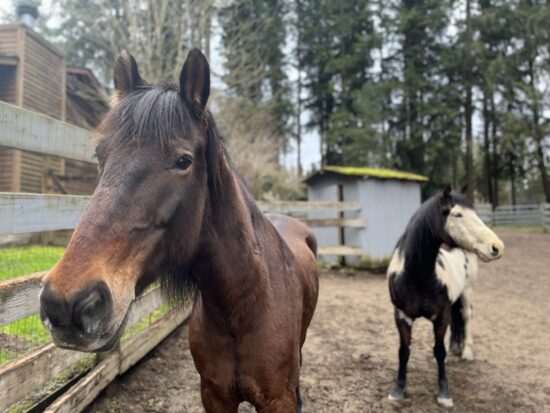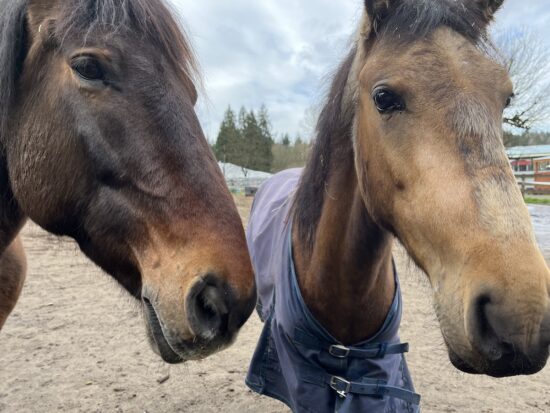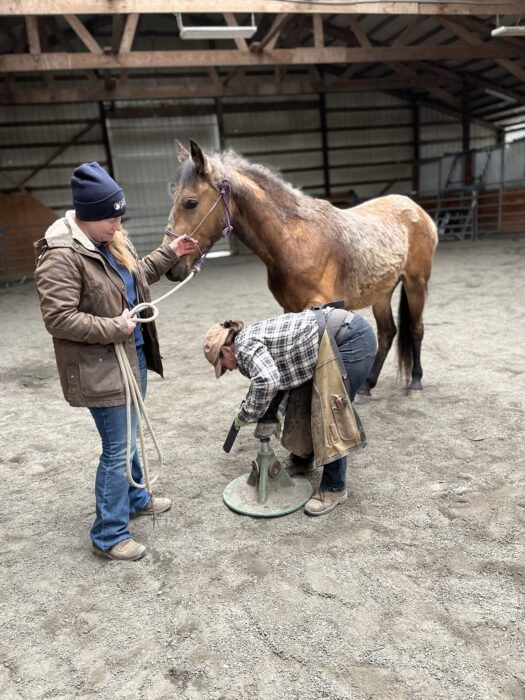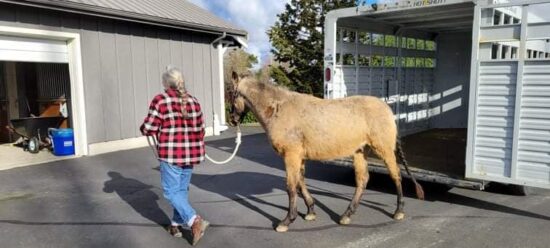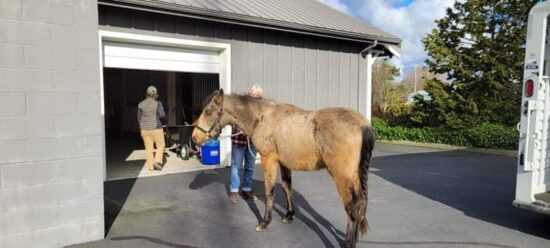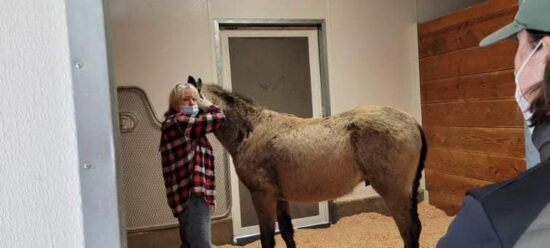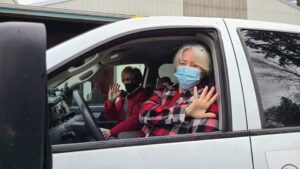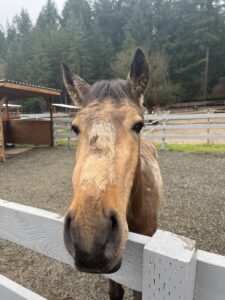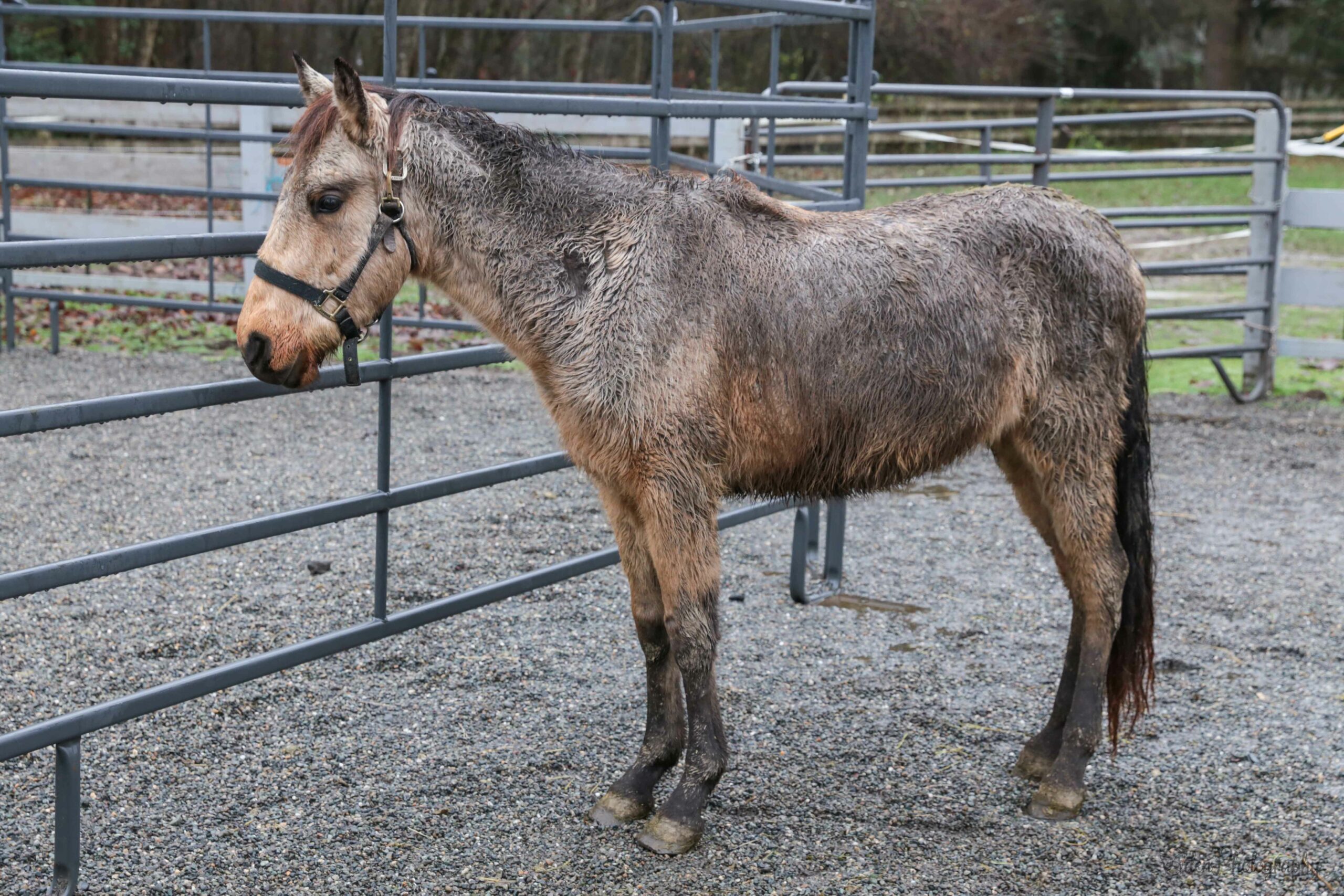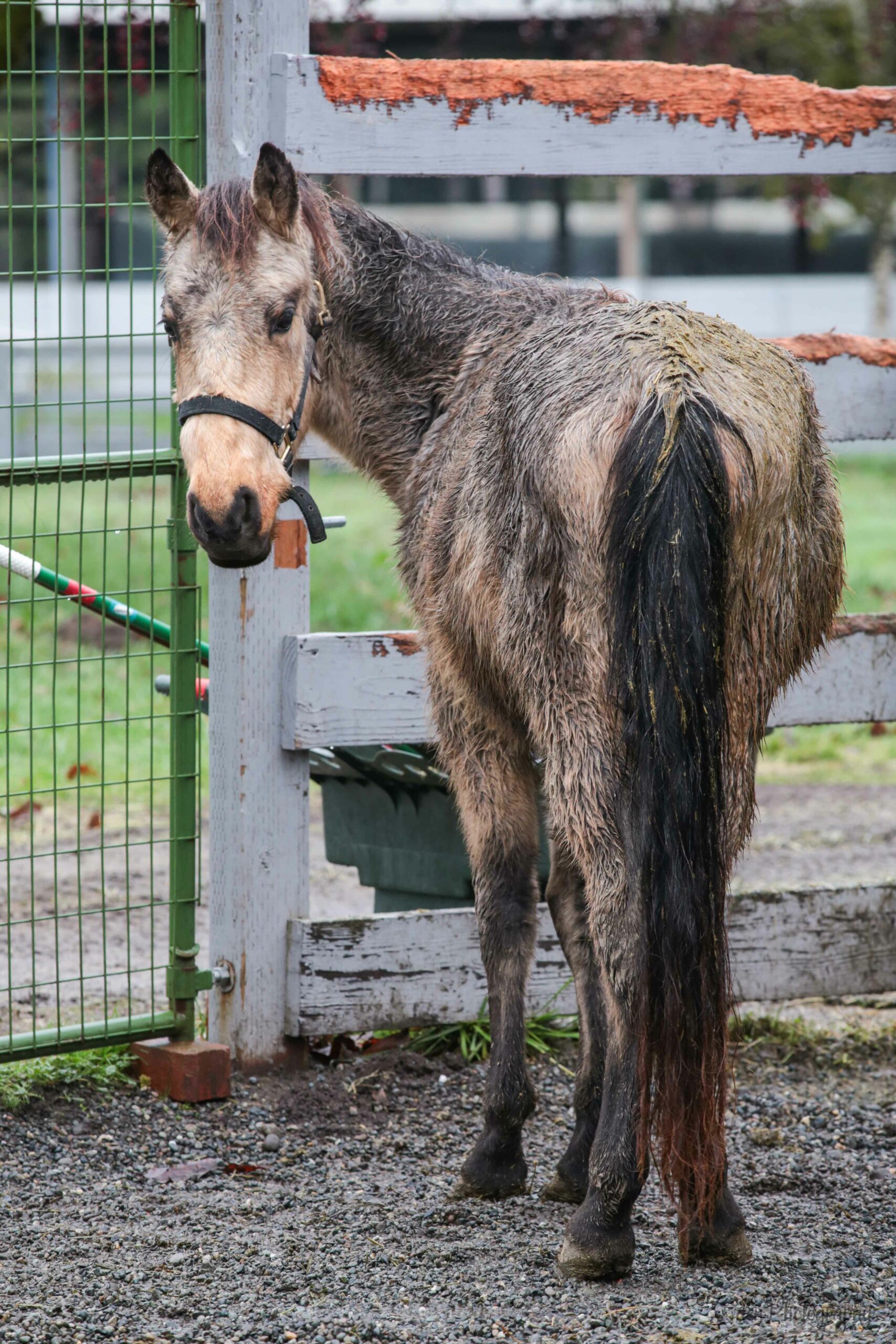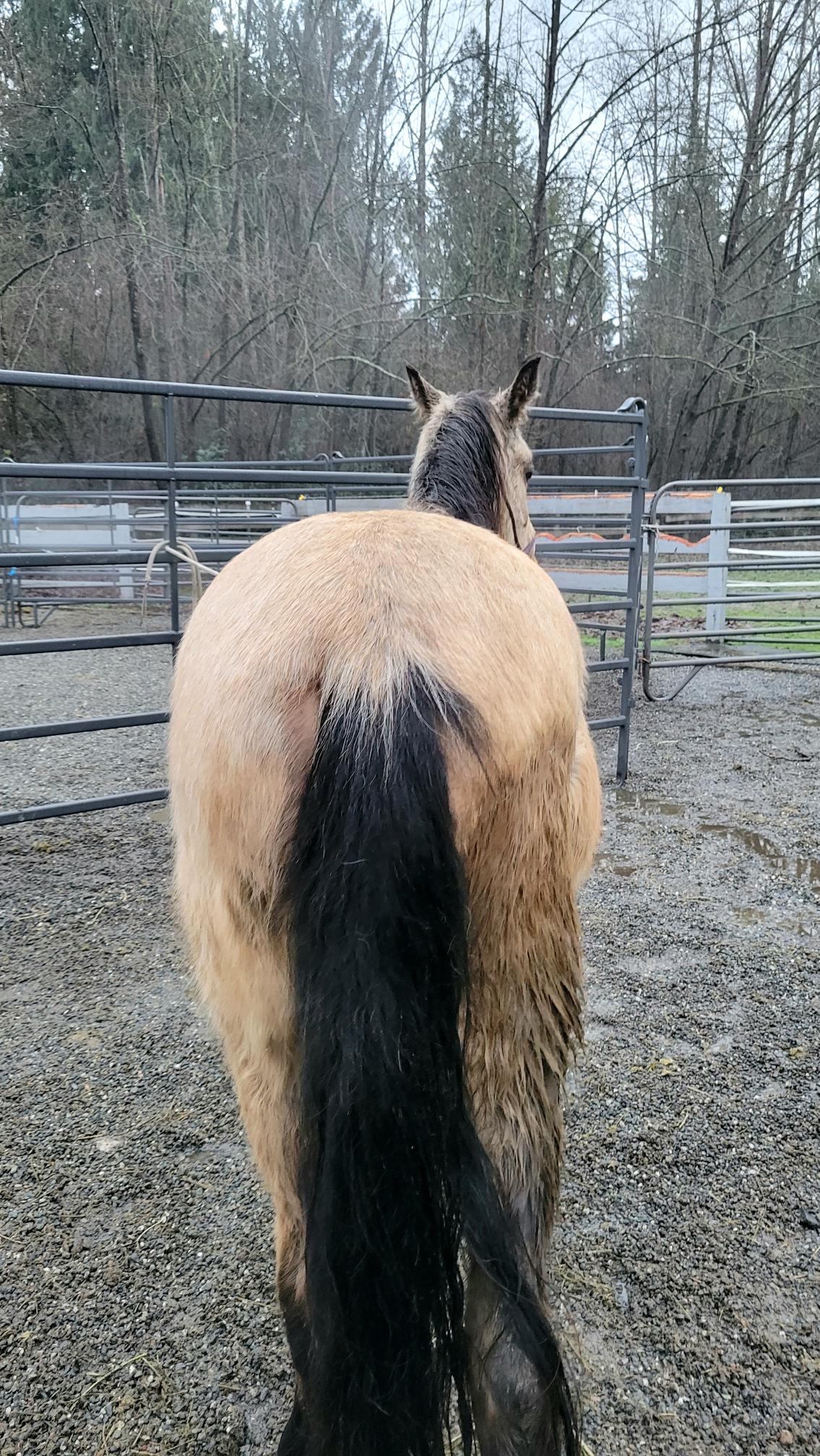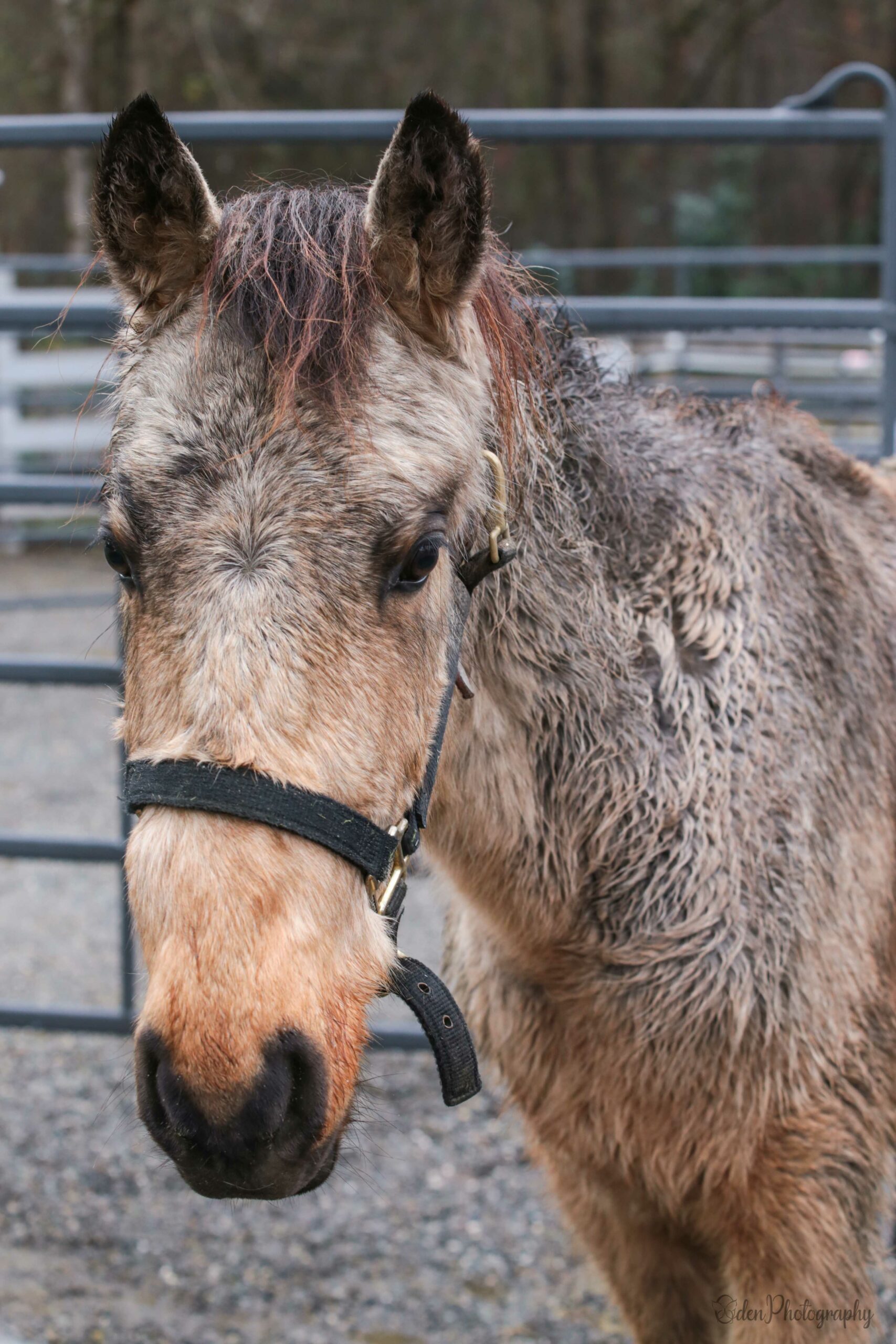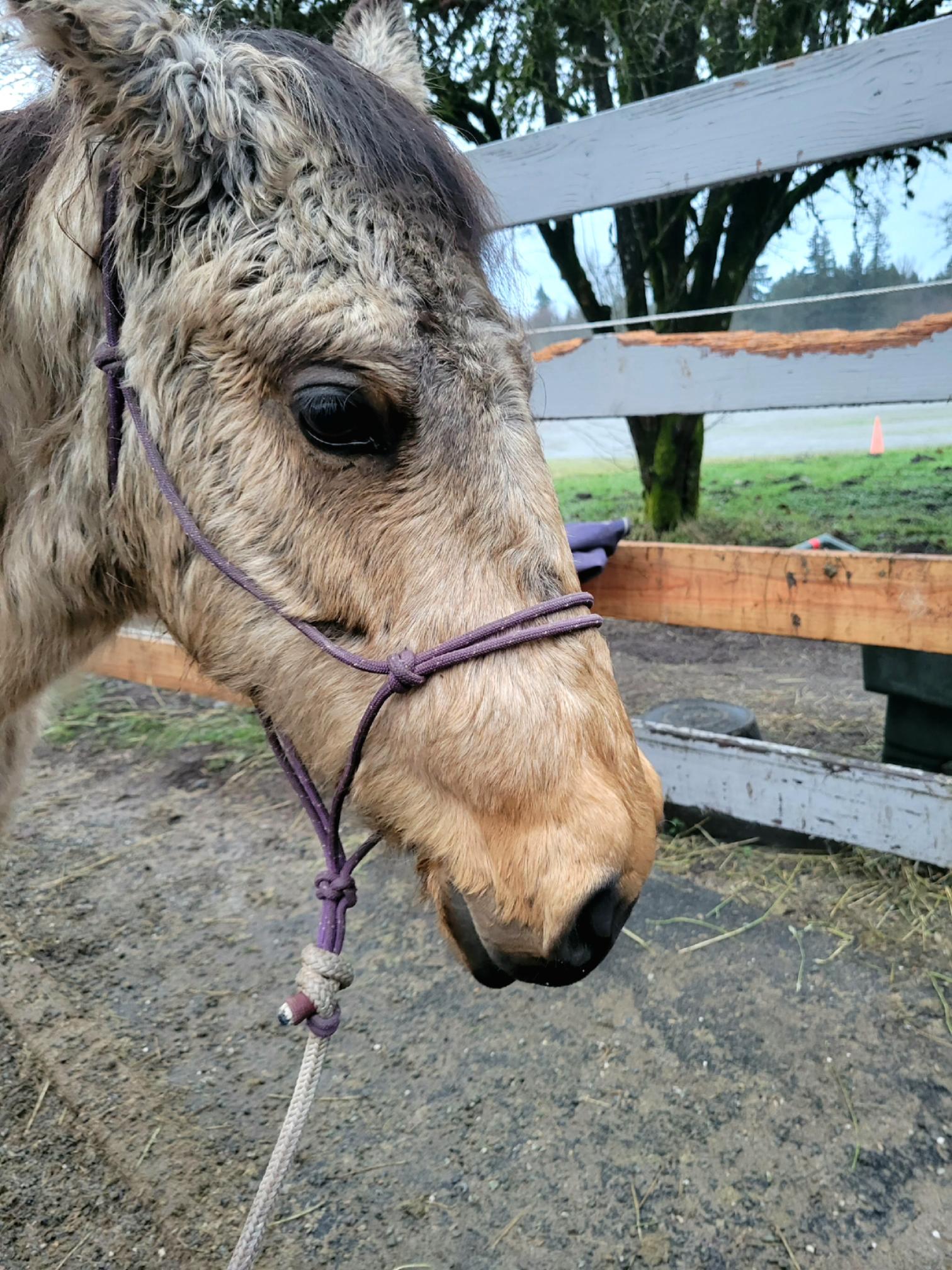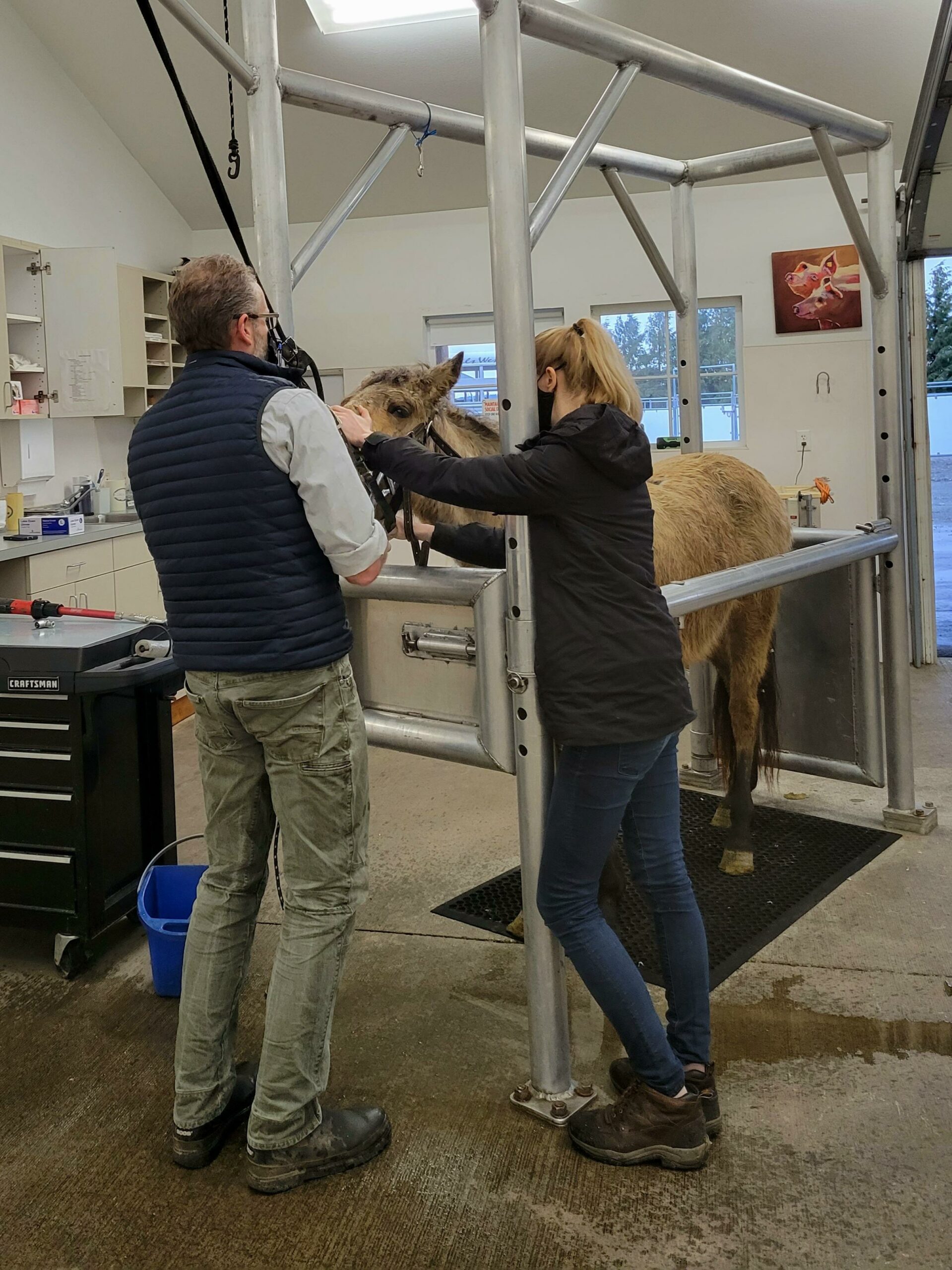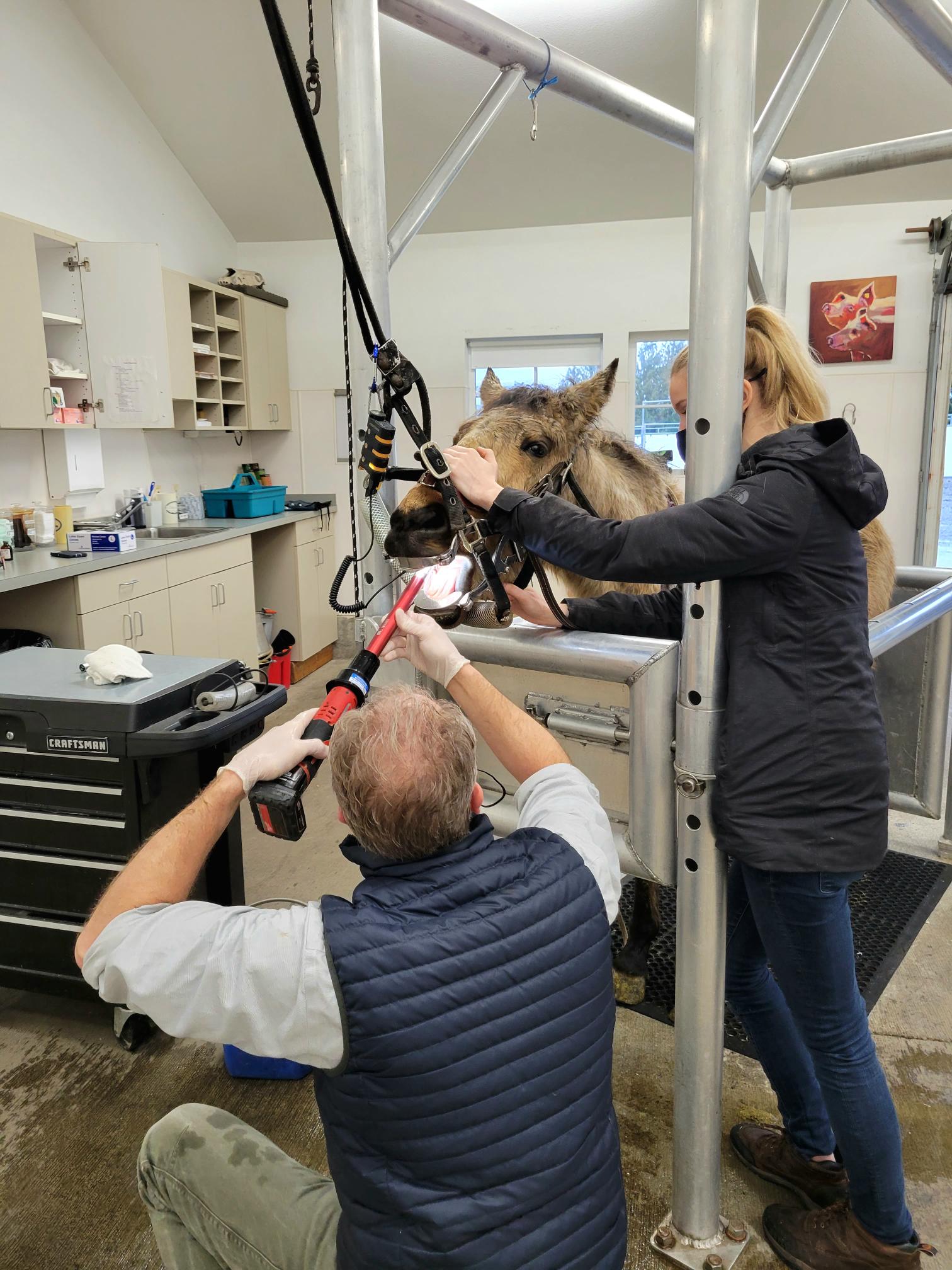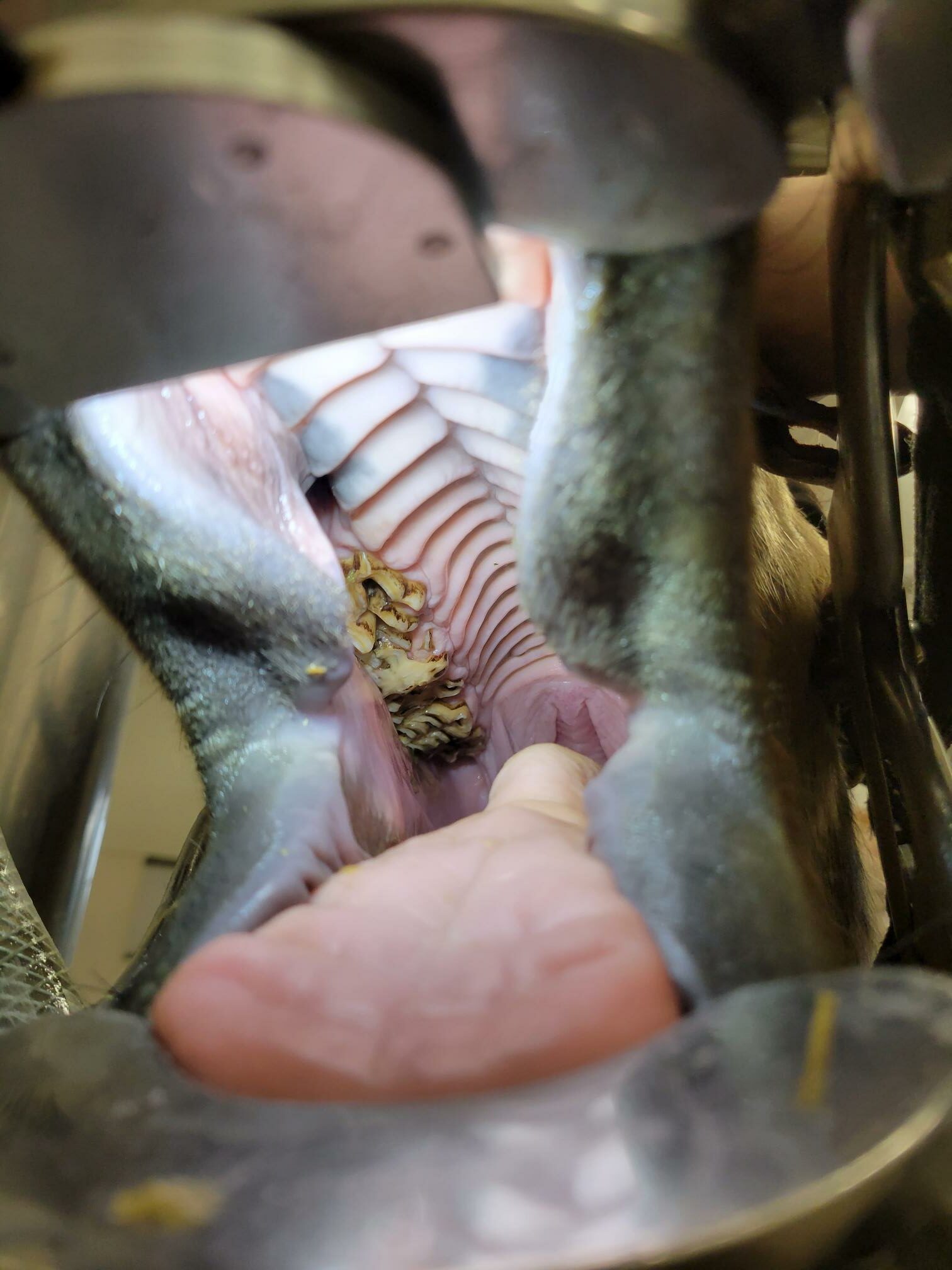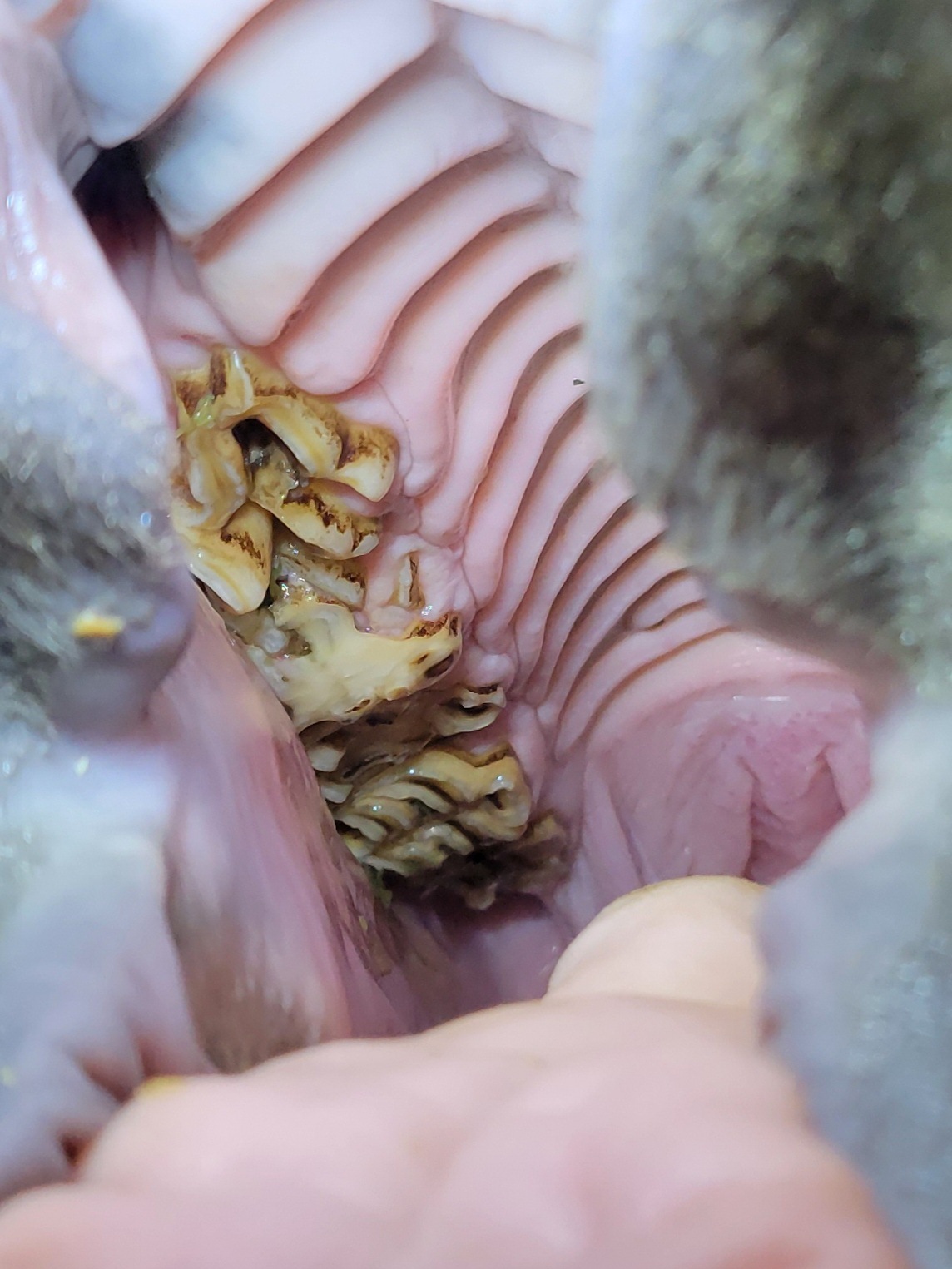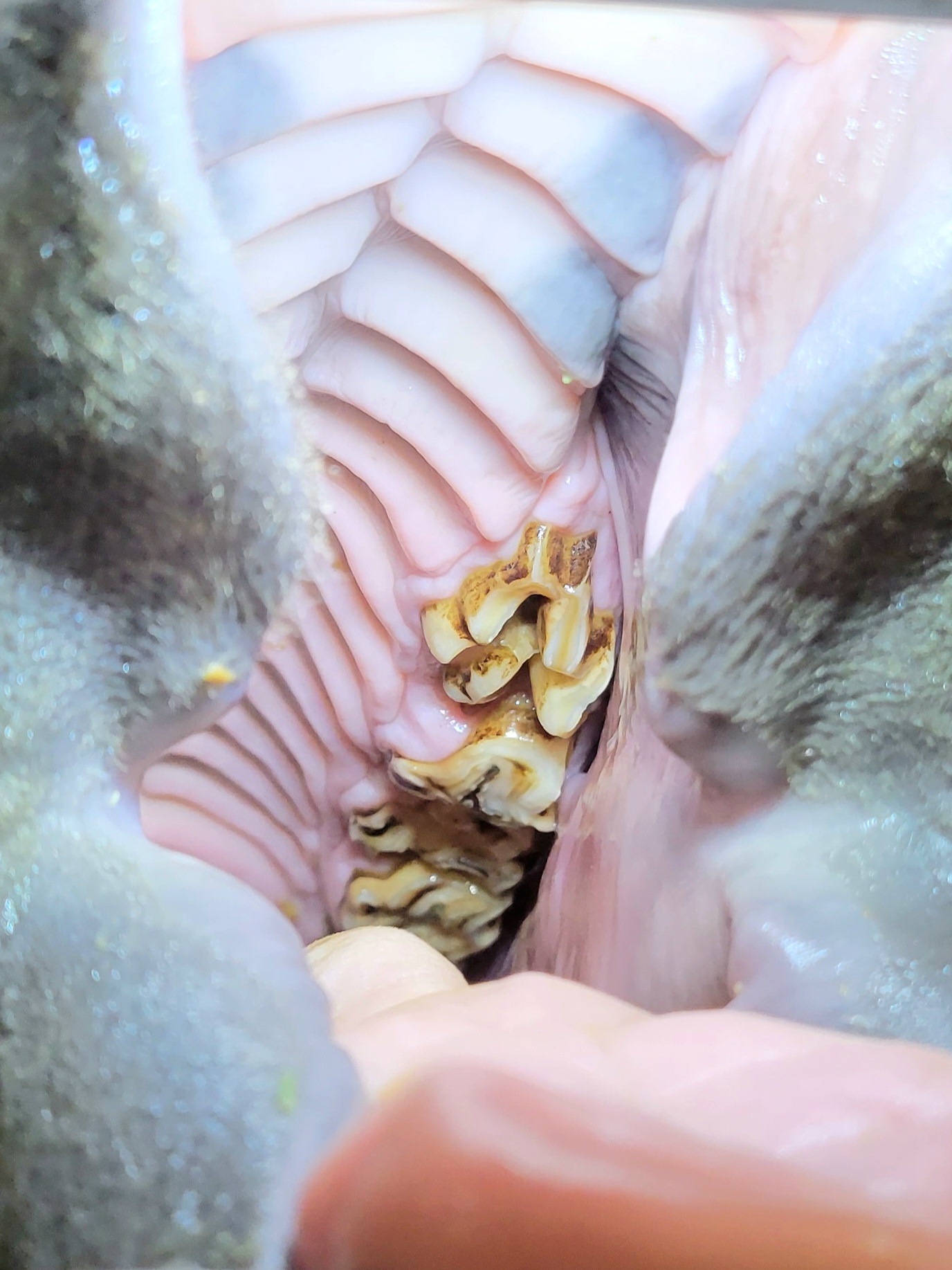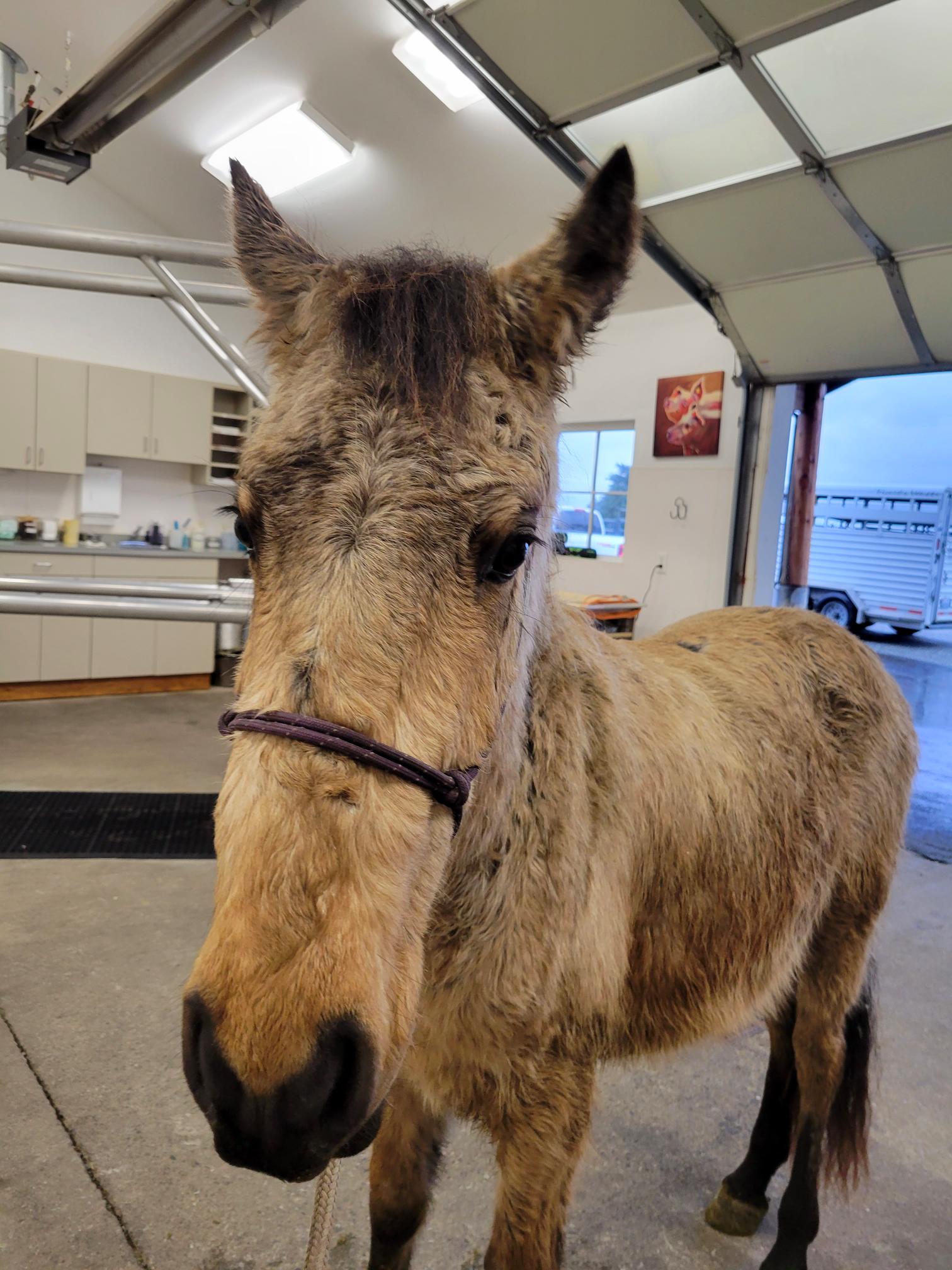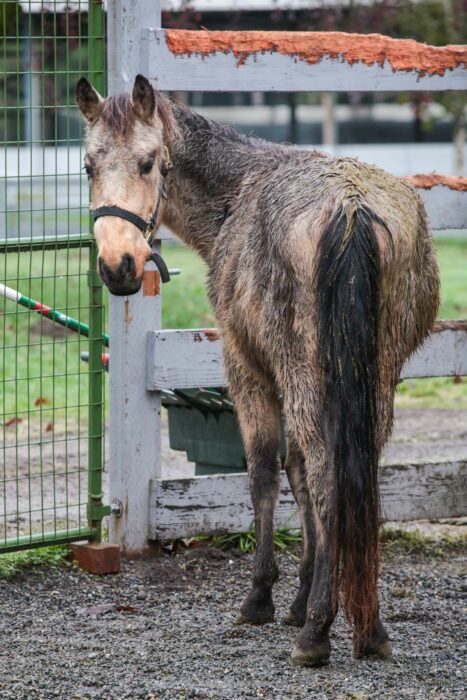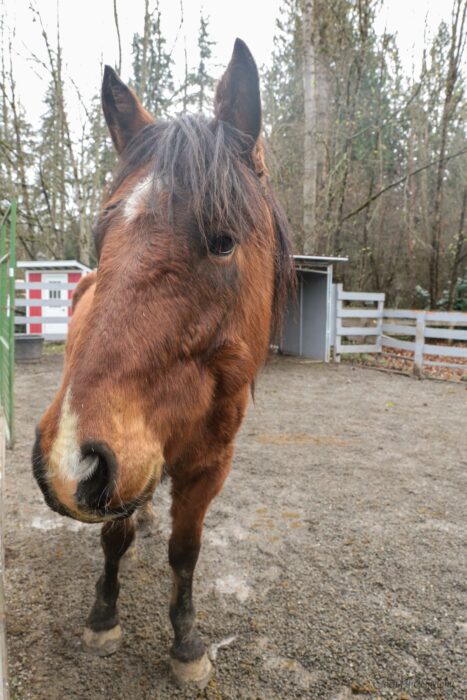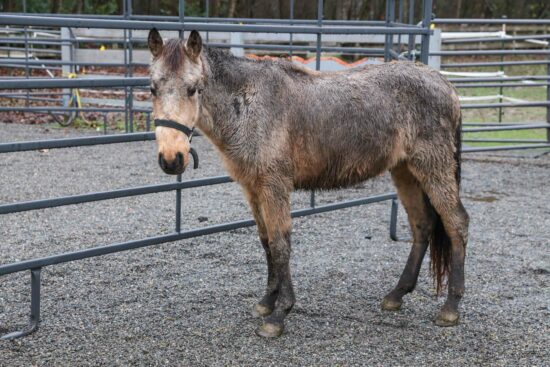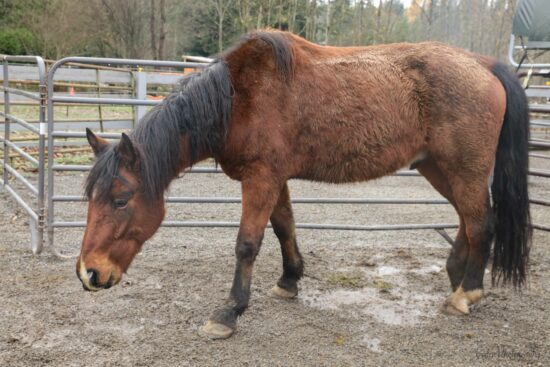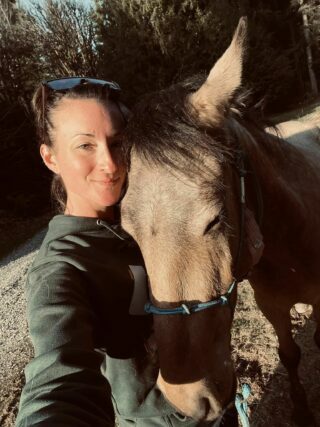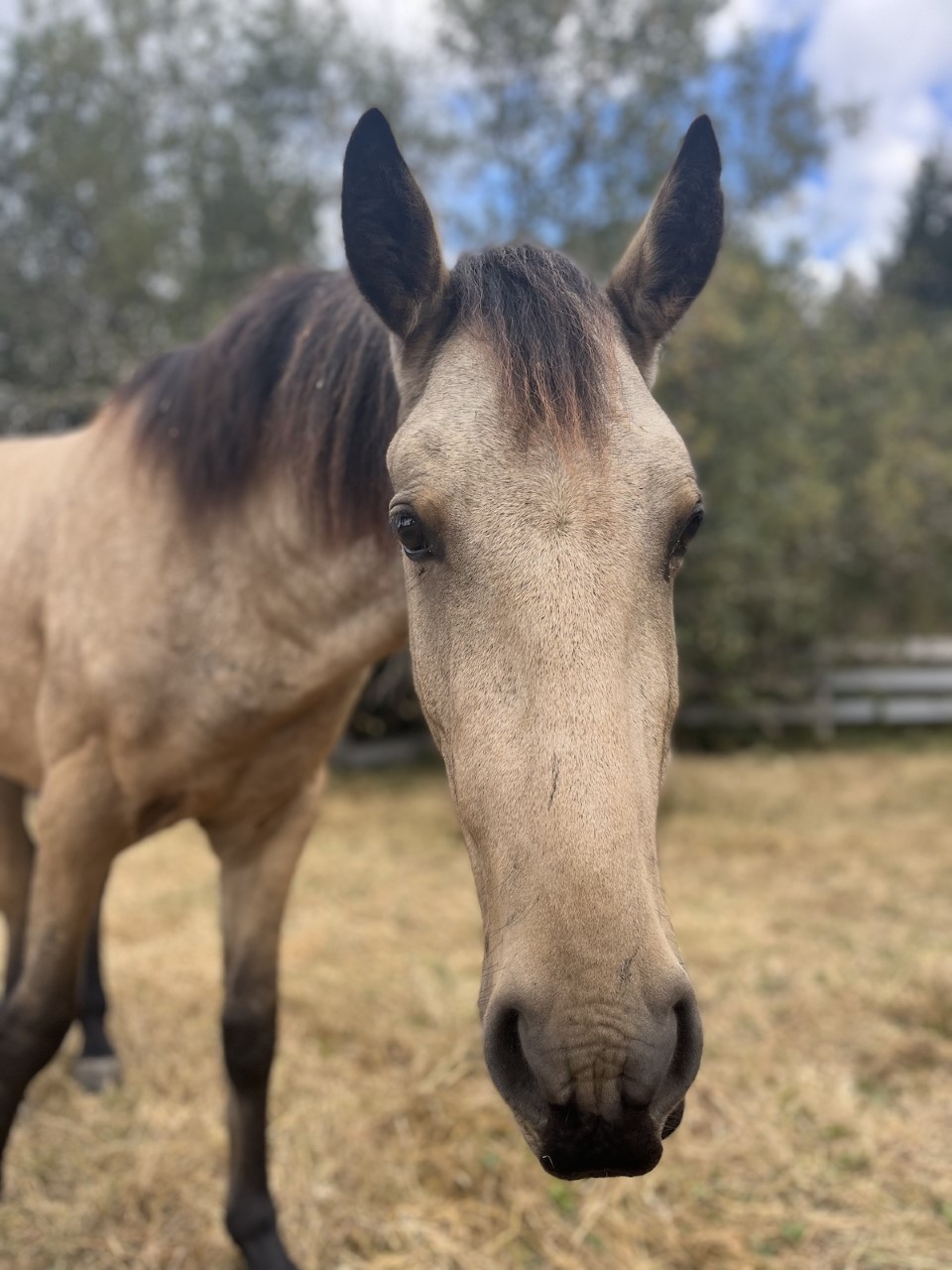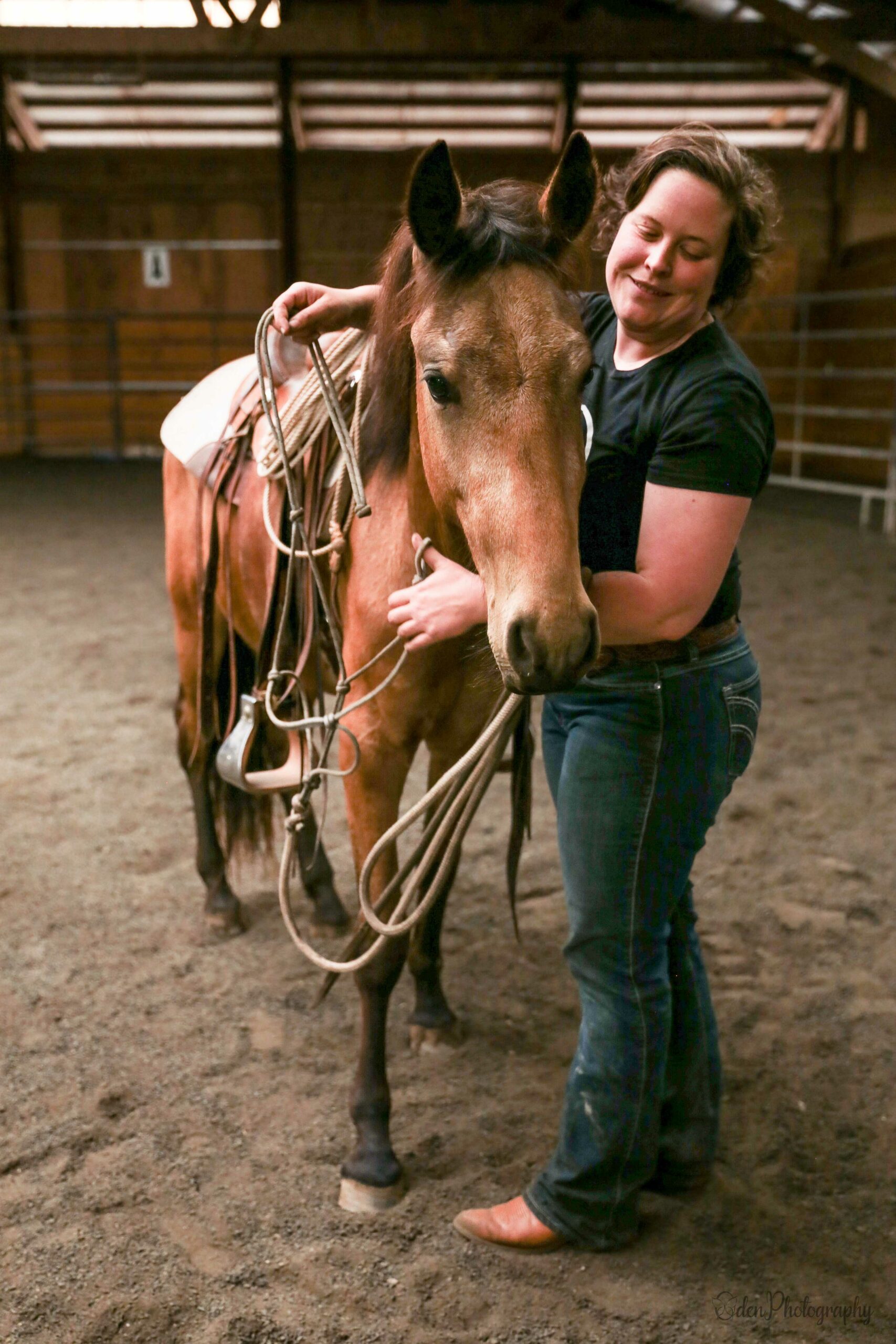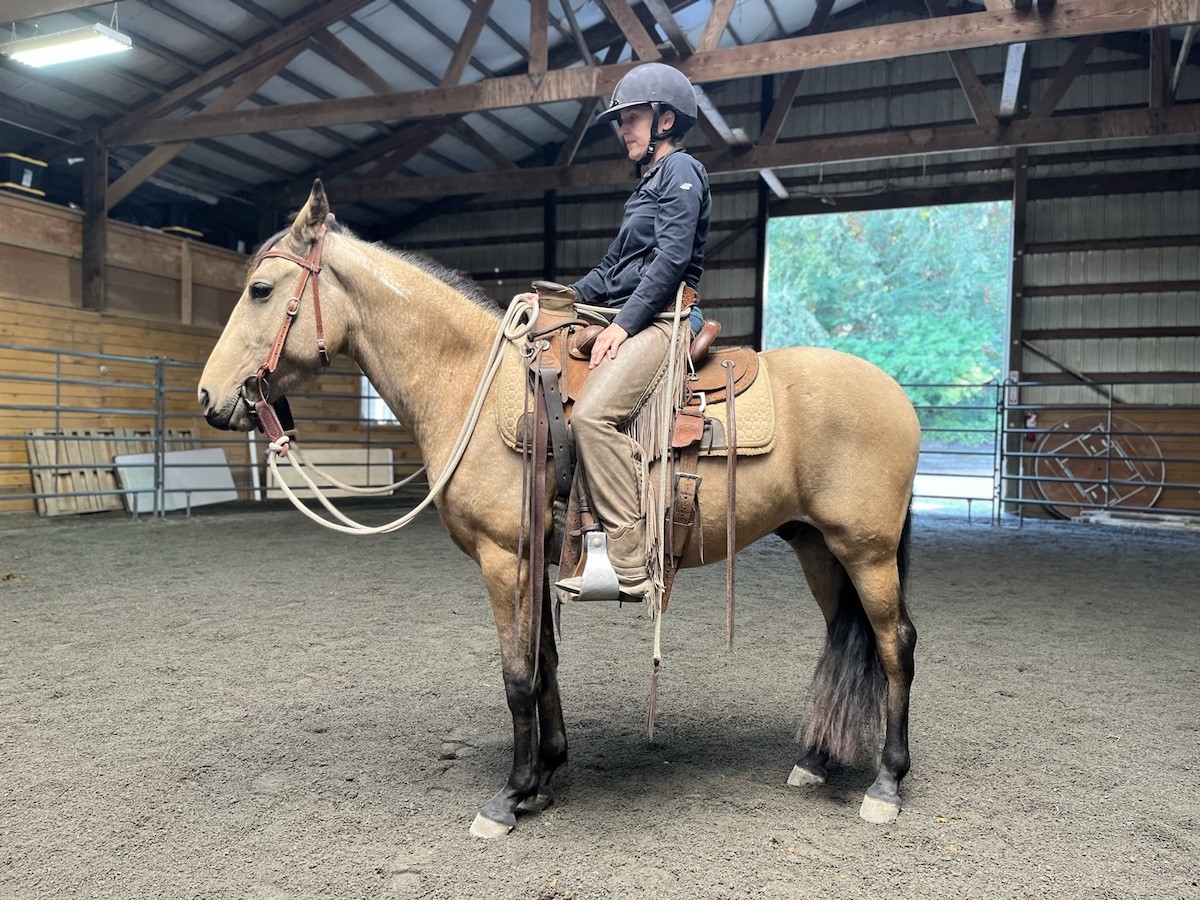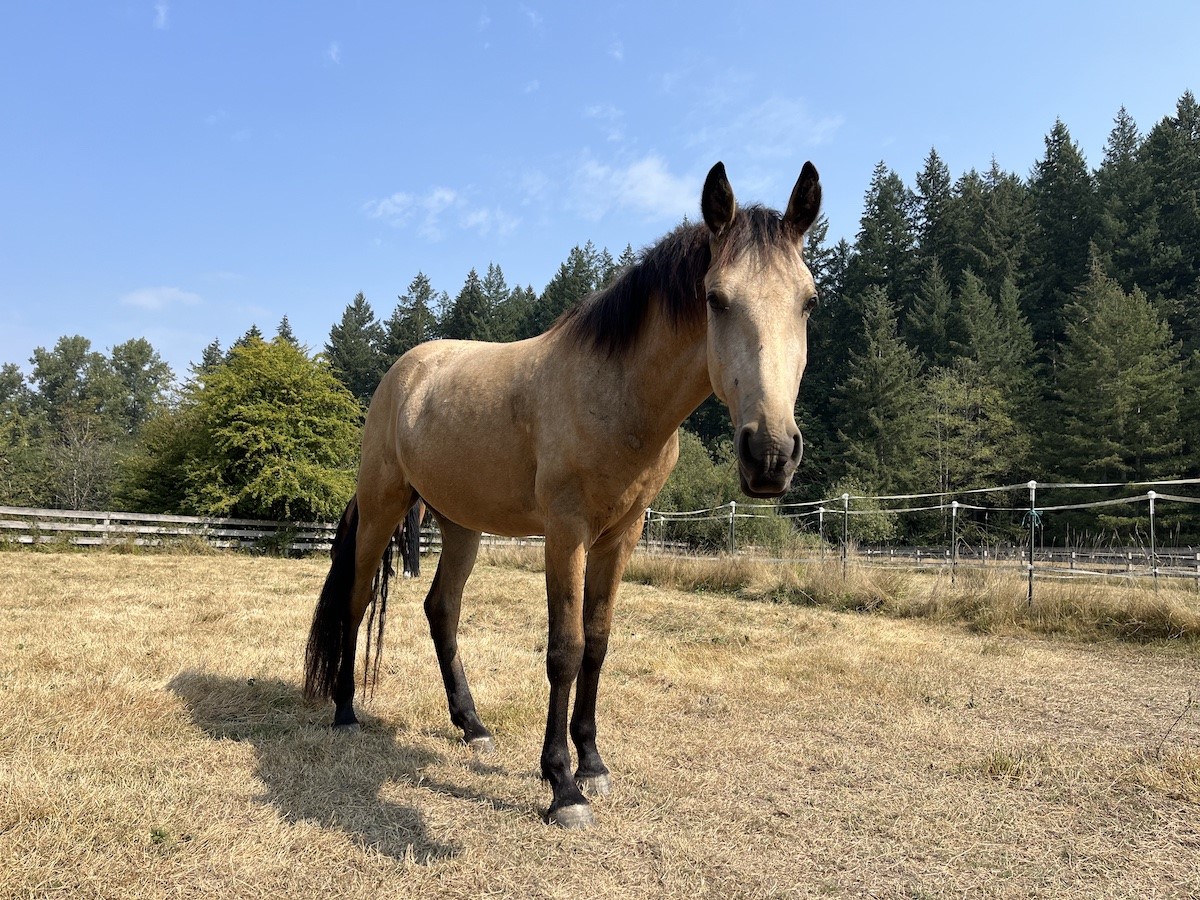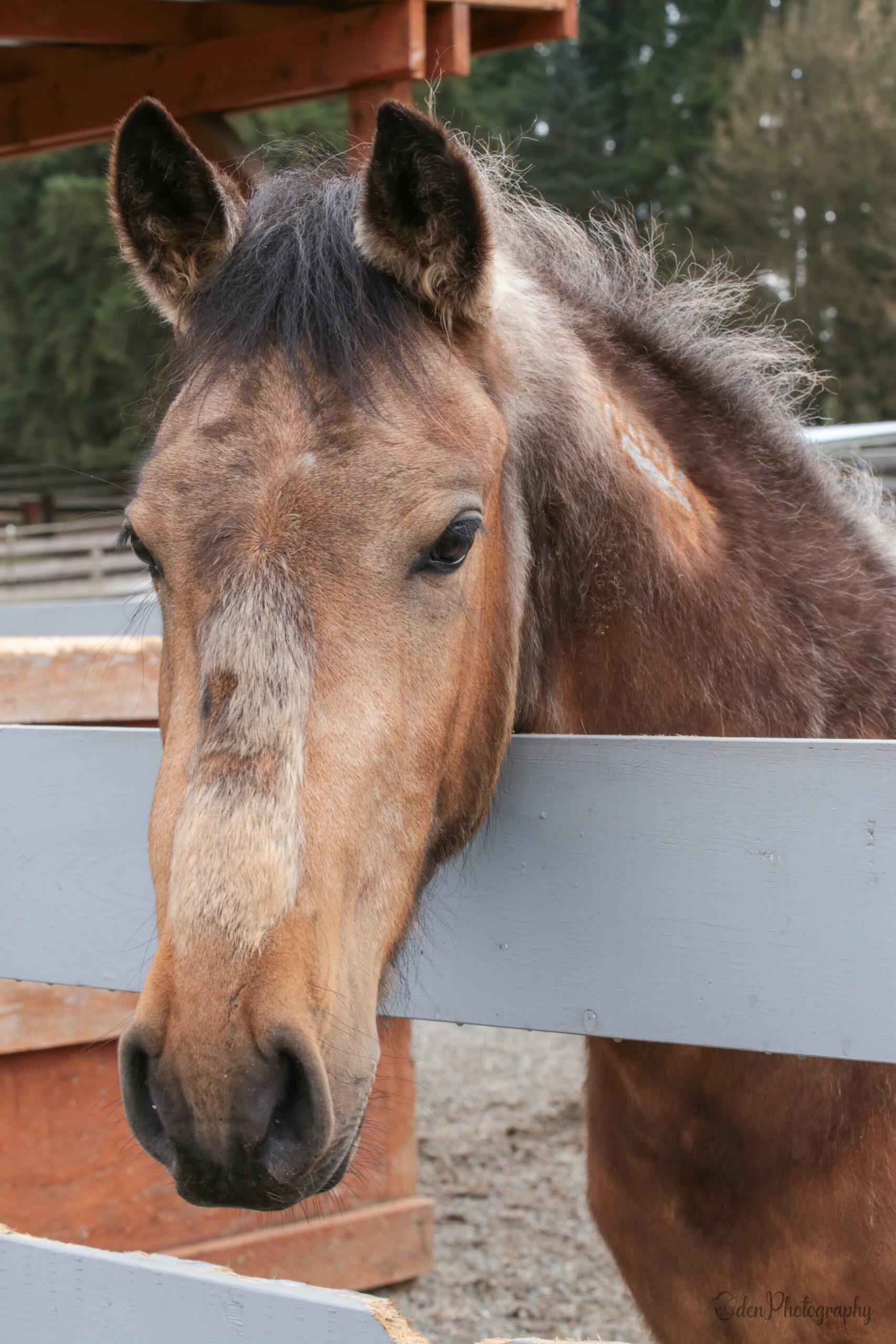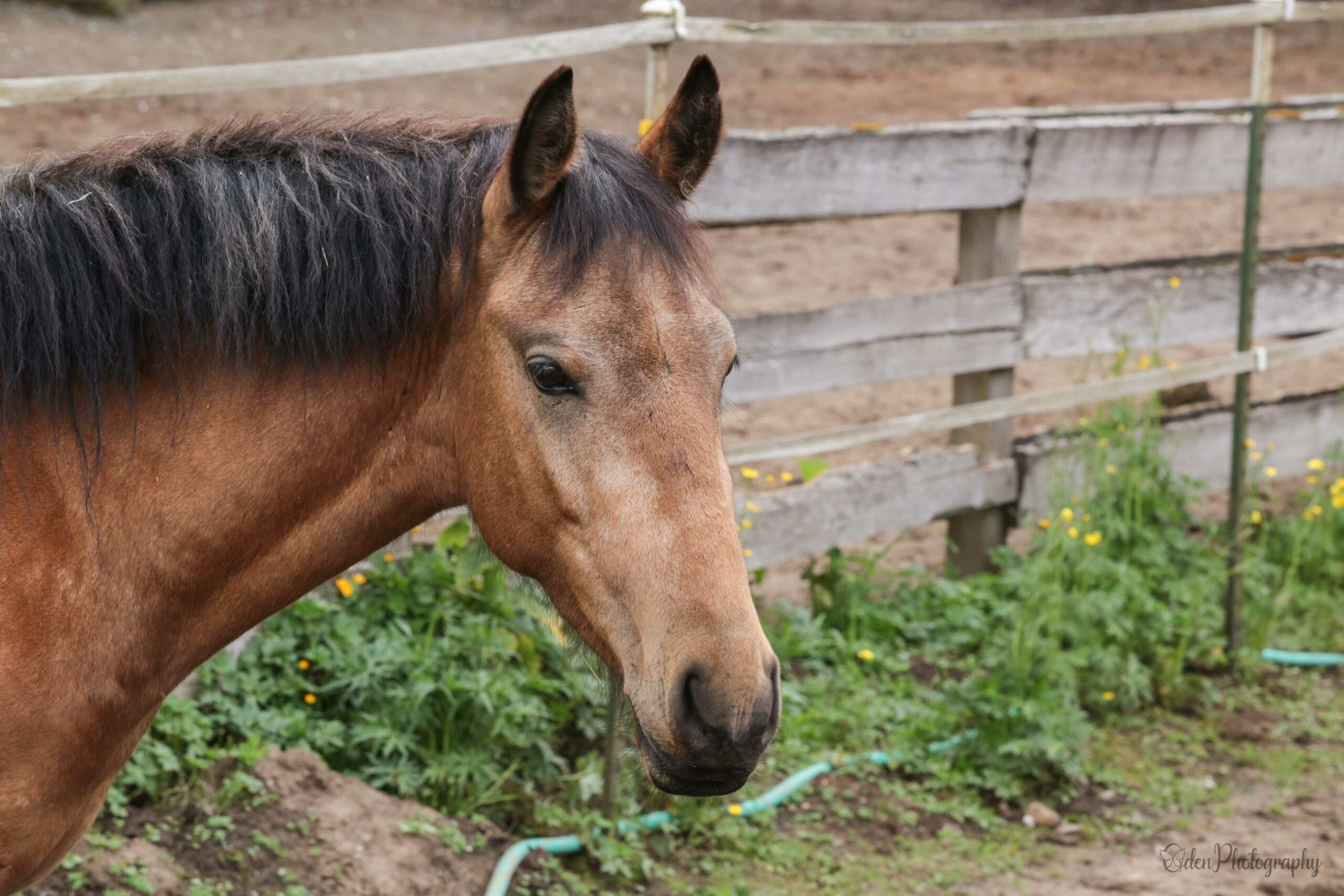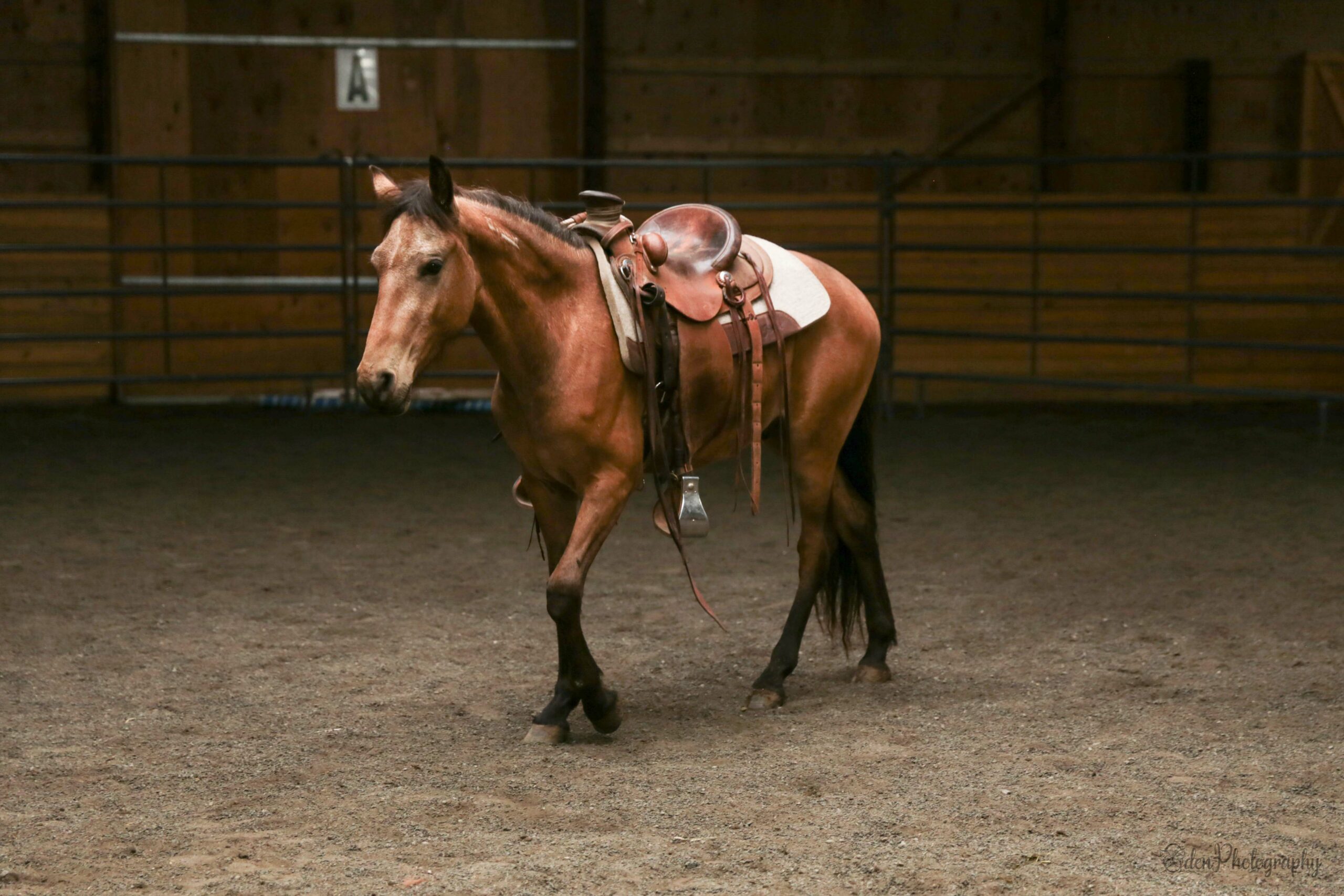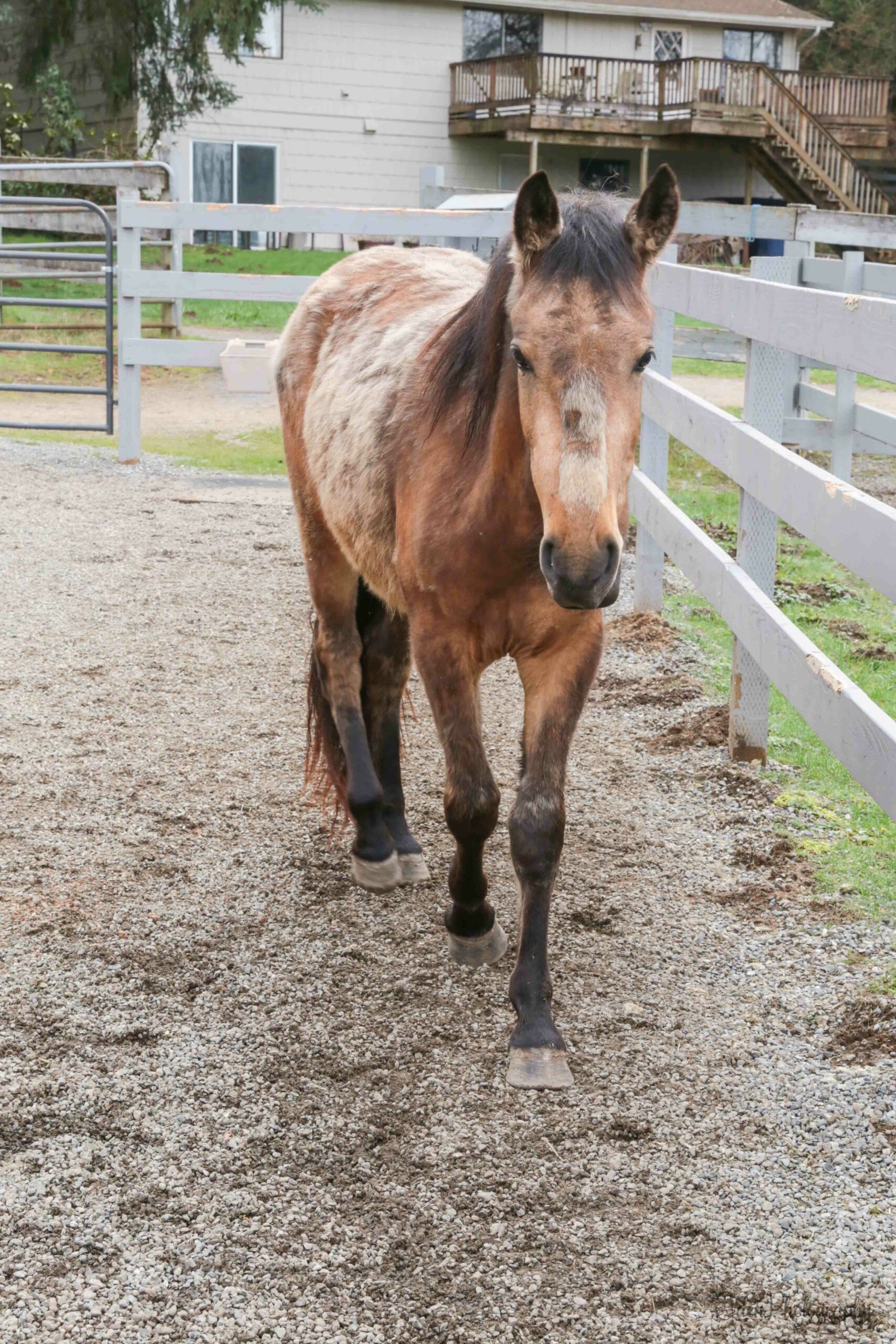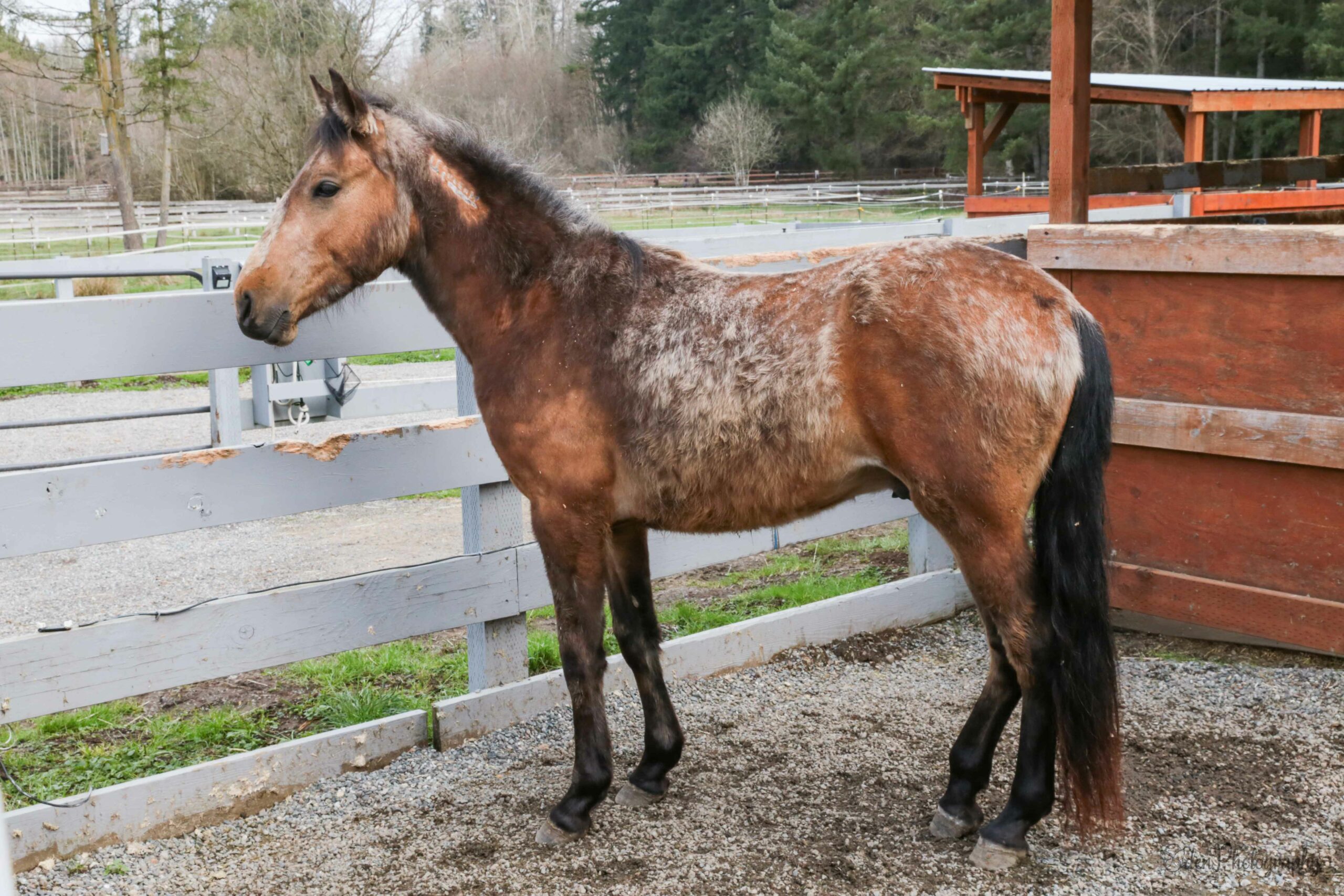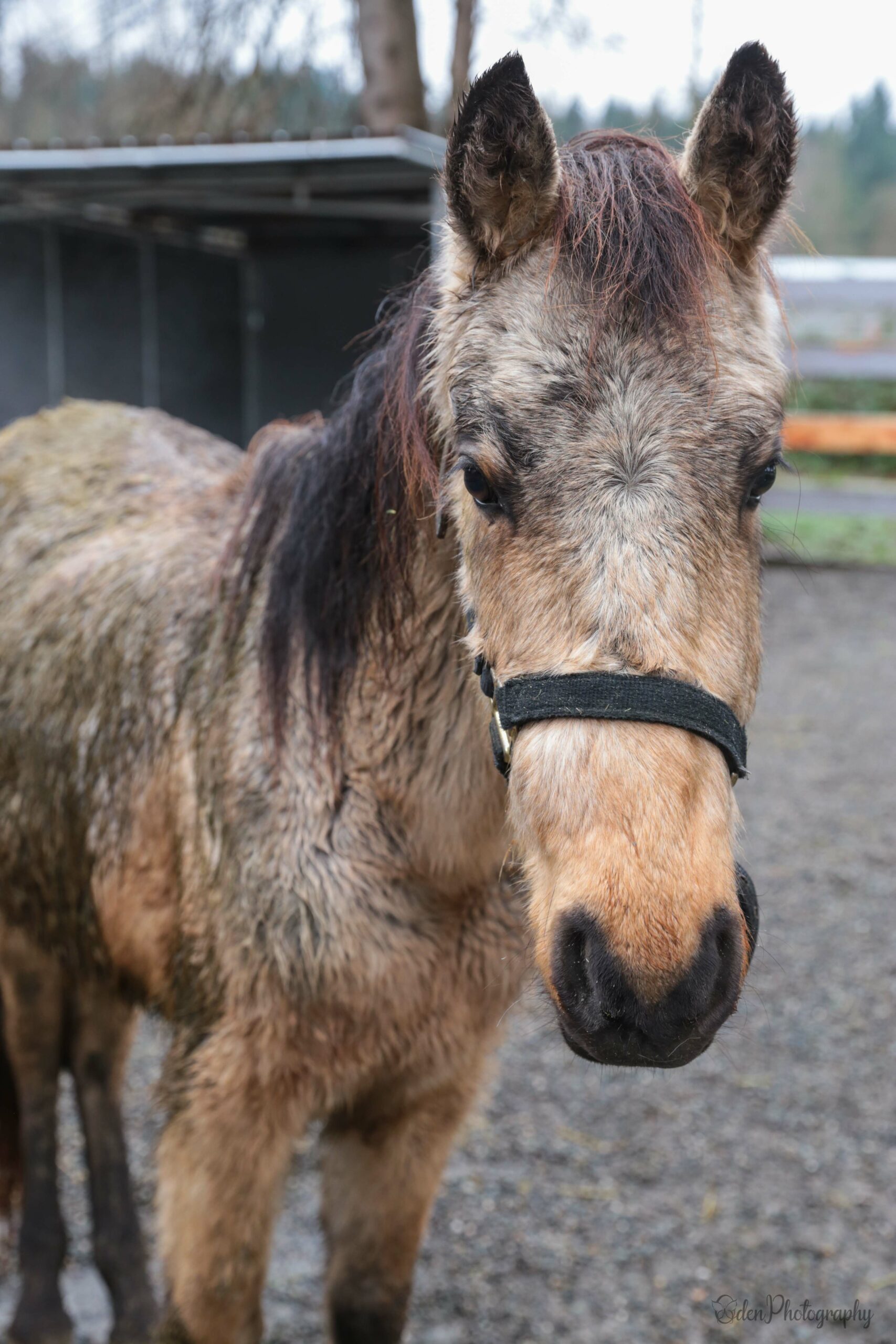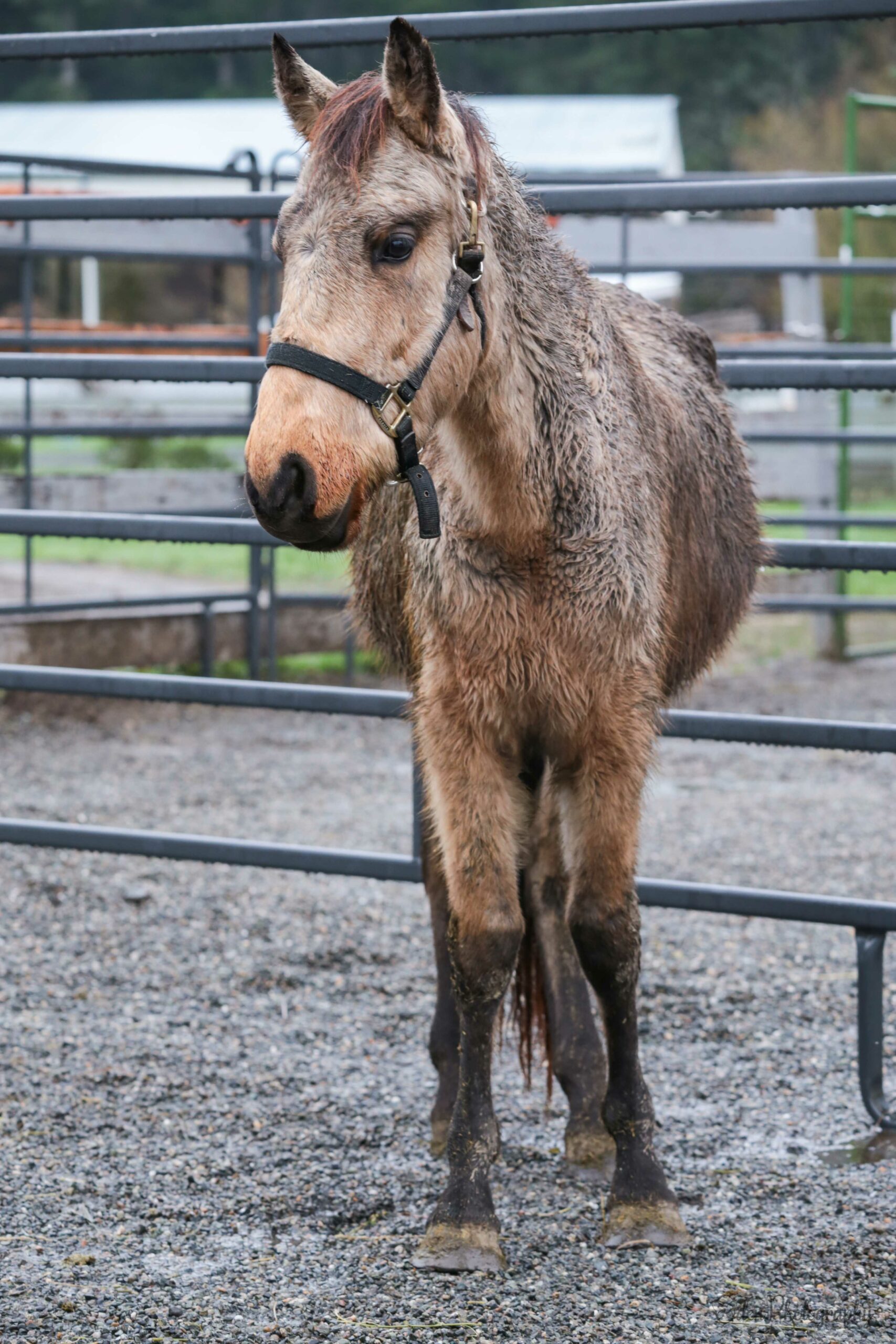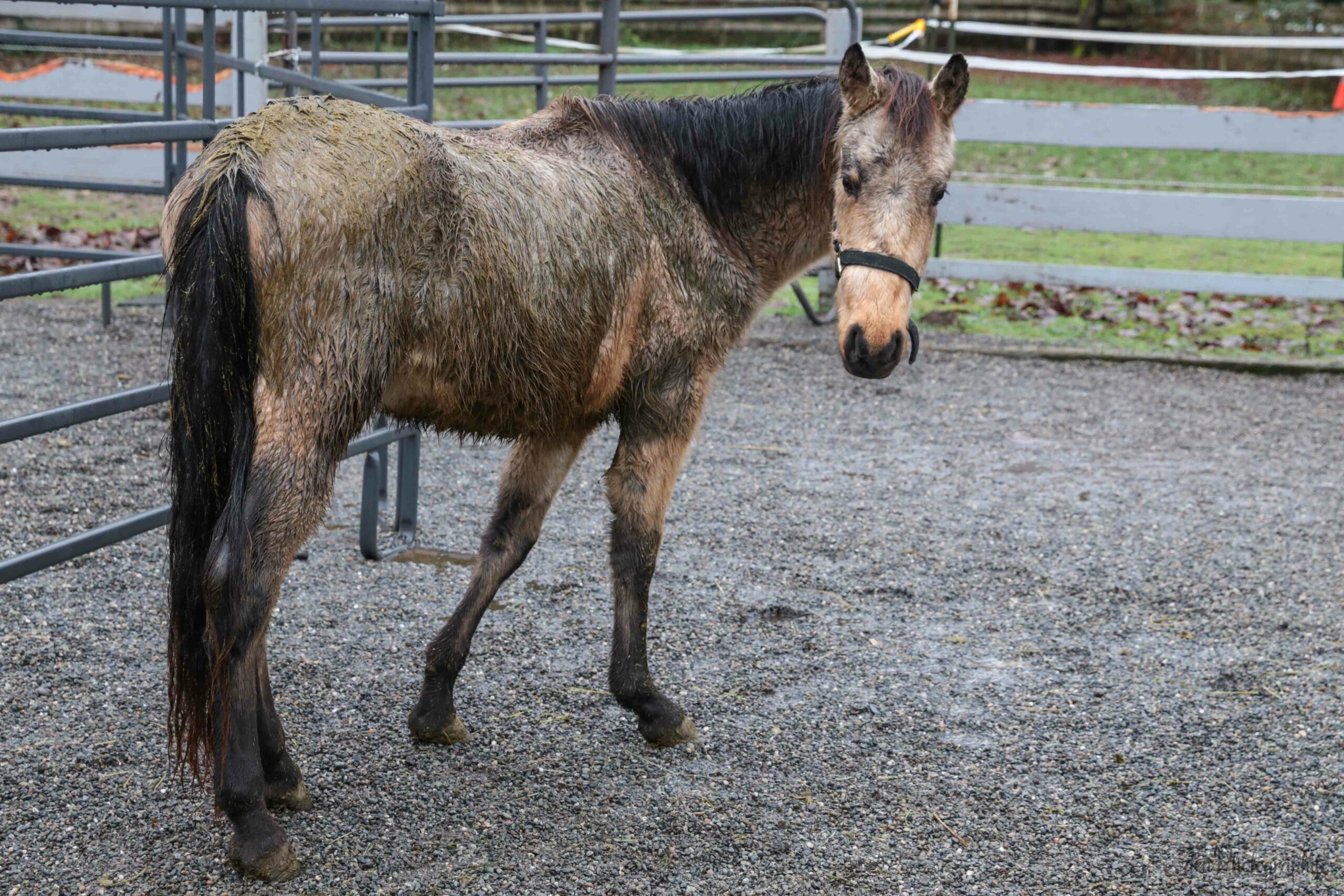Otto
2019 BLM Mustang gelding
Type of Rescue: Animal Control Surrender
Intake Date: 12/6/21
Adoption Date: 3/31/23
Length of Time with SAFE: 1 year 3 months
ADOPTED!! by Gabby
Otto arrived in early December 2021 a few days after his herd mate, Cramer. The two horses were part of a three horse Animal Control seizure. Otto arrived at SAFE in desperate need of some groceries, covered in lice and suffering from a severe tooth infection. Thankfully, Otto made a full recovery, and has transformed into a shiny healthy buckskin gelding. He spent his time in a large paddock with his bestest friend Cramer, along with Montana and Artie. Otto was started under saddle in May of 2022, and did great.
Today
Otto now lives with his new loving family in Darrington! His new life includes a little girl, Evie, who will eventually get to ride Otto, a couple other horses and even a goat. Gabby created Otto’s very own Facebook page where we are thrilled to see regular updates on their active lives and adventures.
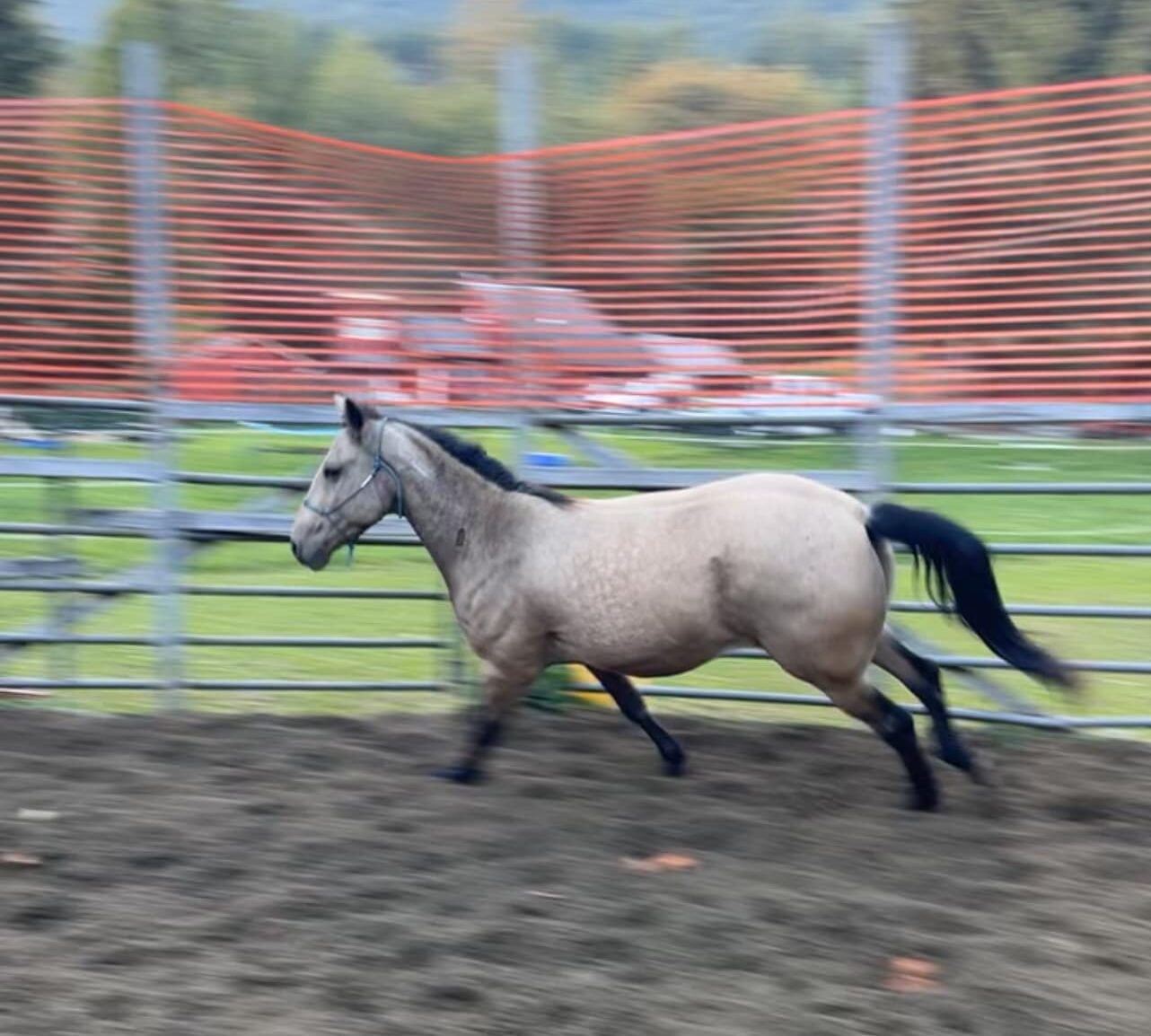
Alumni Update: Otto
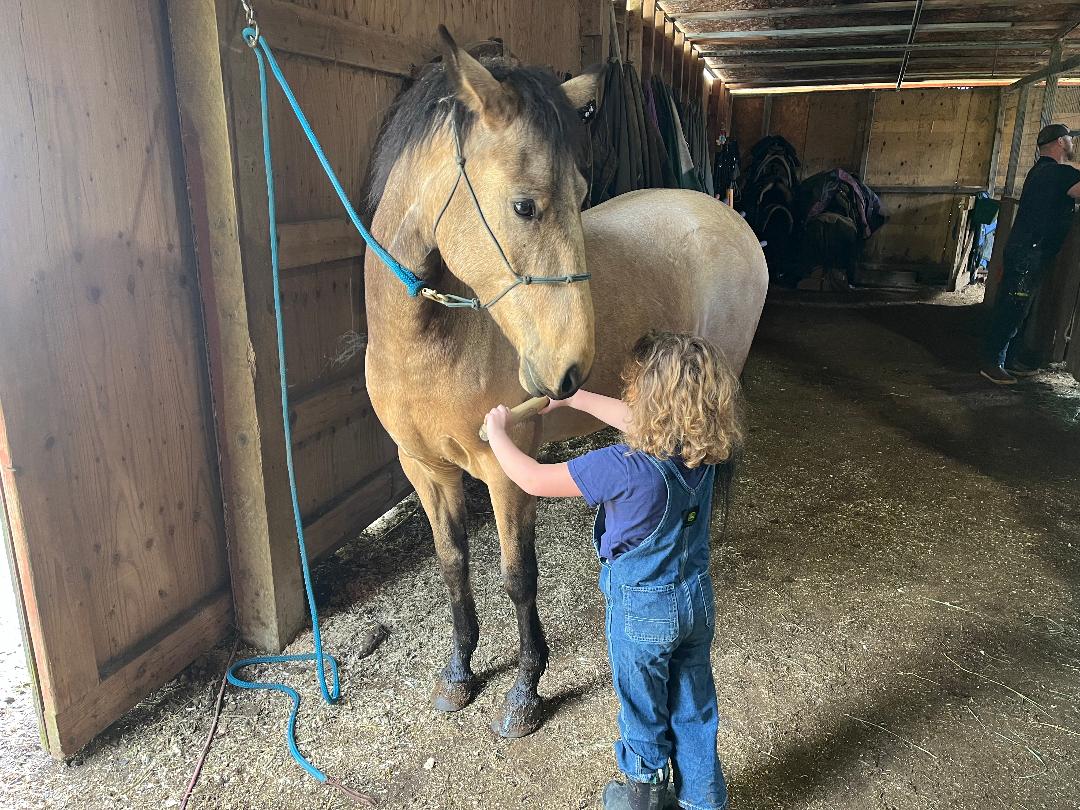
Alumni Update: Otto
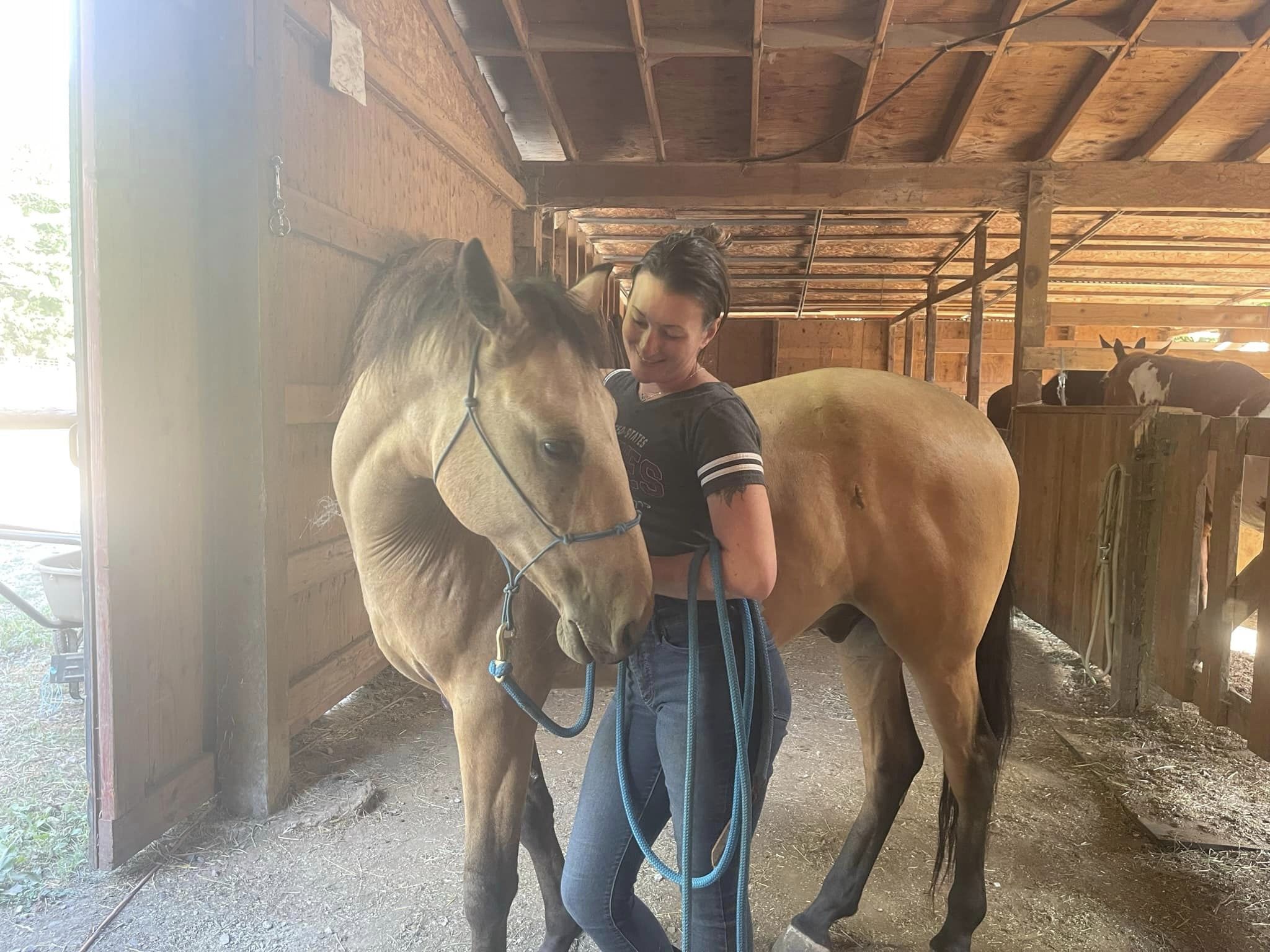
Alumni Update: Otto
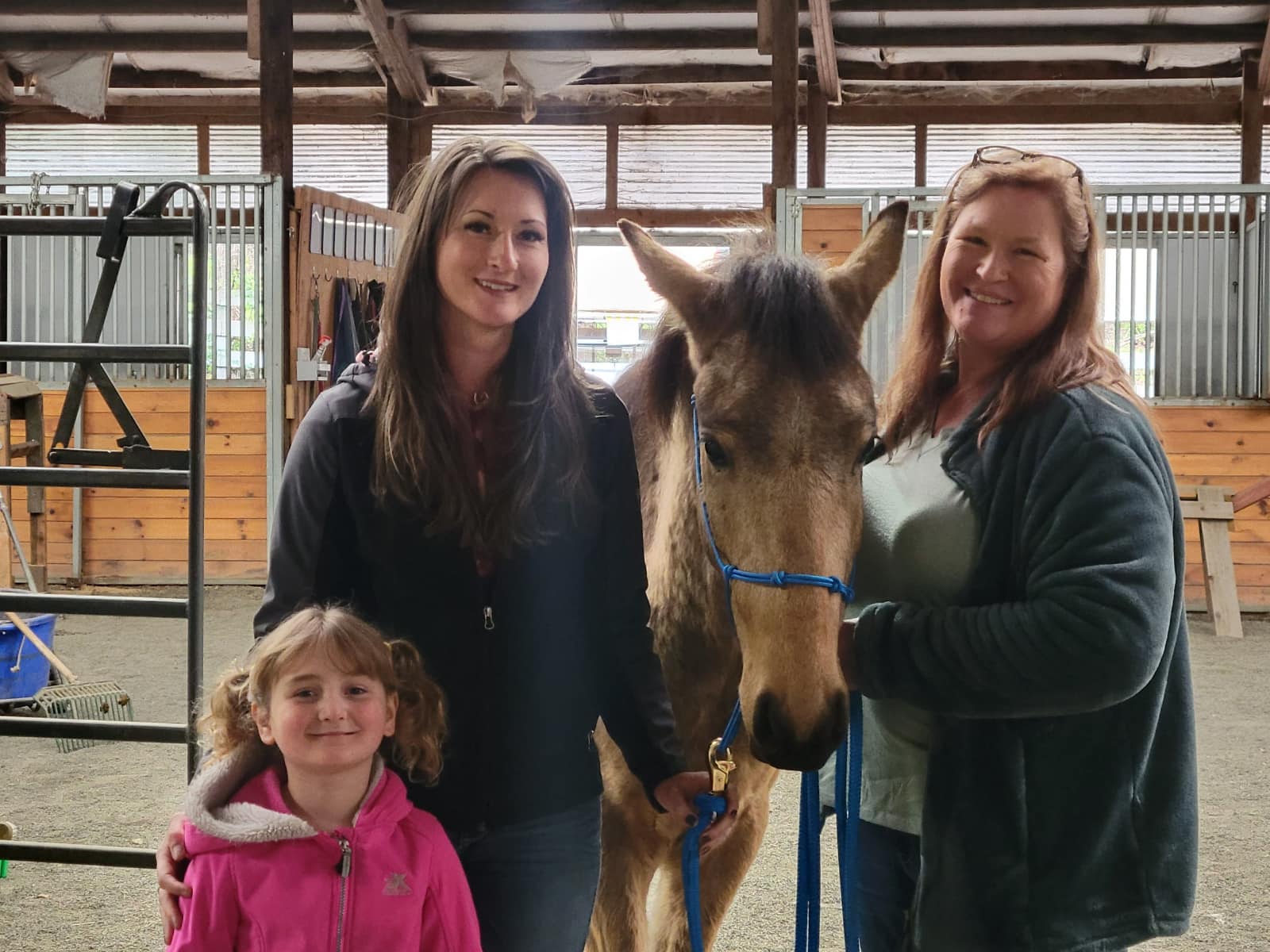
Otto is Adopted!
Otto was born to the desert, raised alongside sun-warmed rocks and plump lizards in the wilds of Nevada. He was rounded up, tattooed, and, via some circumstances unknown to us, found his way to Washington.
A boy of only three, some of his adult teeth still sitting unerupted, Otto experienced something most horses will be lucky enough never to even imagine: being seized by Animal Control.
When he arrived at SAFE, he was sick from an infected tooth, and looking, if not exactly beat-up, definitely beat-down. With his scraggly, manure-stained coat, a mane and tail in a muddy tangle, and a face bumped out from infection, Otto was in need of some immediate TLC.
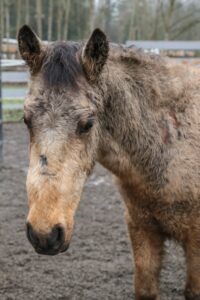 Over the months, he began to transform. He had his infected tooth removed. The seasons changed and his coat began to shed, transforming him from the dishwater color he’d arrived as into a toasted marshmallow of a gelding. He began learning ground manners, and proved to be a very fast learner. He made friends in a herd of geldings: sharing hay nets with big friend Cramer, and playing the day away with Artie. Under saddle, he was a relatively easy start, a brave boy who didn’t have a tendency to give his riders any trouble. He trailered off-site to a clinic, and kept his level head in all sorts of new environments and situations. He really was, in all ways including color, a golden boy.
Over the months, he began to transform. He had his infected tooth removed. The seasons changed and his coat began to shed, transforming him from the dishwater color he’d arrived as into a toasted marshmallow of a gelding. He began learning ground manners, and proved to be a very fast learner. He made friends in a herd of geldings: sharing hay nets with big friend Cramer, and playing the day away with Artie. Under saddle, he was a relatively easy start, a brave boy who didn’t have a tendency to give his riders any trouble. He trailered off-site to a clinic, and kept his level head in all sorts of new environments and situations. He really was, in all ways including color, a golden boy.
Gabby recognized Otto from his previous life, sometime between the sands of Nevada and the time he arrived at SAFE. It was kismet that this boy would cross her path again, transformed in so many ways, and ready for the next step with someone exactly like her. As someone with experience with green horses, Gabby was the perfect fit for Otto.
So on the trailer he hopped, ending his chapter here at SAFE to begin the next alongside his new loving family. Otto has already been hard at work at his new home: exploring new places, hanging out with his goat siblings, and continuing his great education both on the ground and under saddle.
We are over the moon for our sweet boy, and can’t wait to follow his journey.
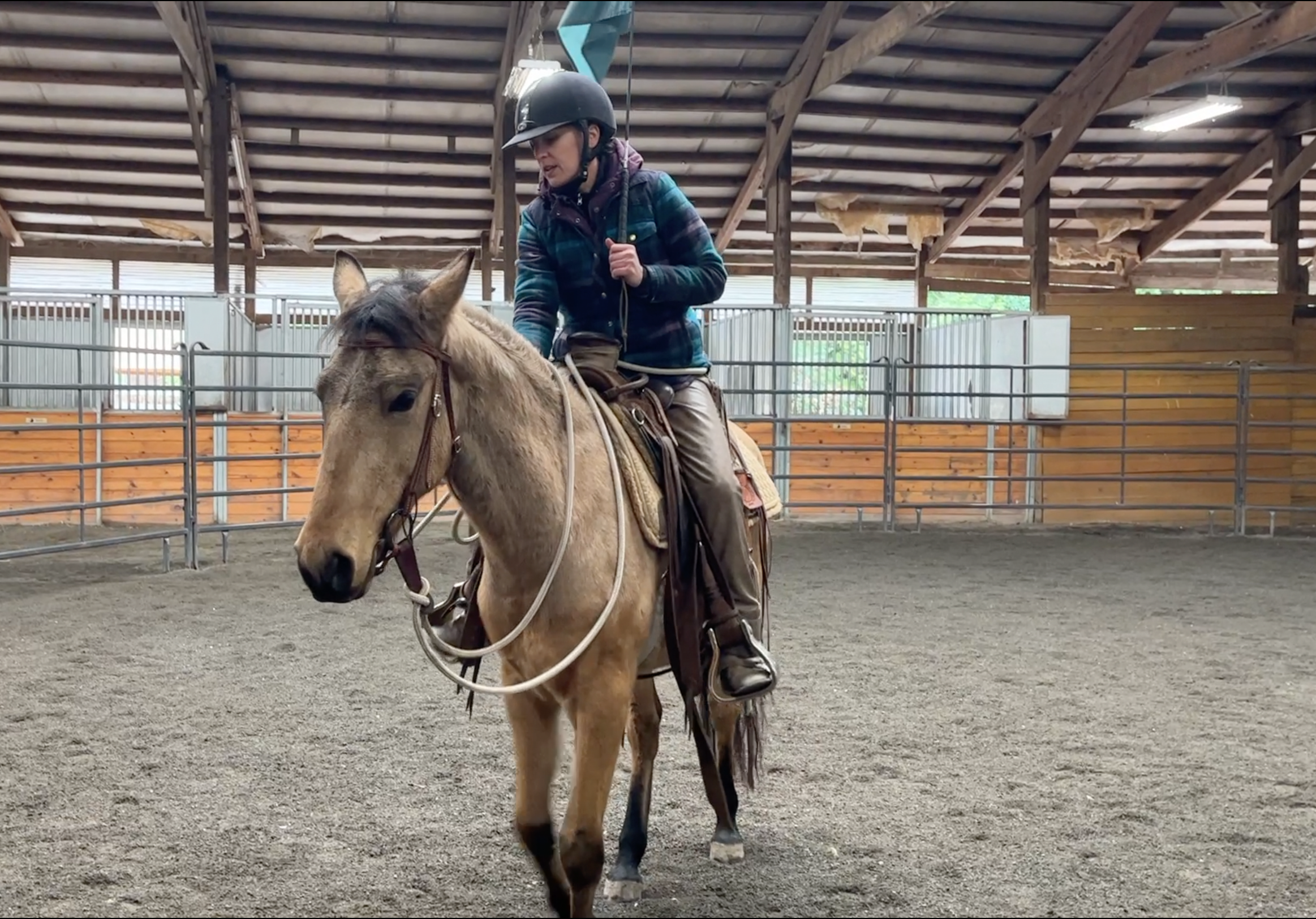
Training Update: Flagging Off Otto
Otto’s fourth birthday just passed, and it’s hard to believe that the little sickly boy with the infected tooth who arrived at the end of 2021 is now such a solid (and healthy!) riding horse. Casey A, who has been spending the most time riding and working Otto over the last months delights in this guy’s softness and try, and has been enjoying the time they spend together, both on the ground and under saddle. She has really helped him blossom into the special partner he is today, clearly shown in the below video where she flags off of him at the walk, trot, and canter while he remains completely unbothered. Such a feat did not happen overnight — there was once a time when Otto flinched away from the flag, but those days are long over, and the nervous Otto of a year ago has been replaced by a gelding who is confident under saddle and easily talked out of trouble by his rider. One thing is for sure, Otto is one special little dude!
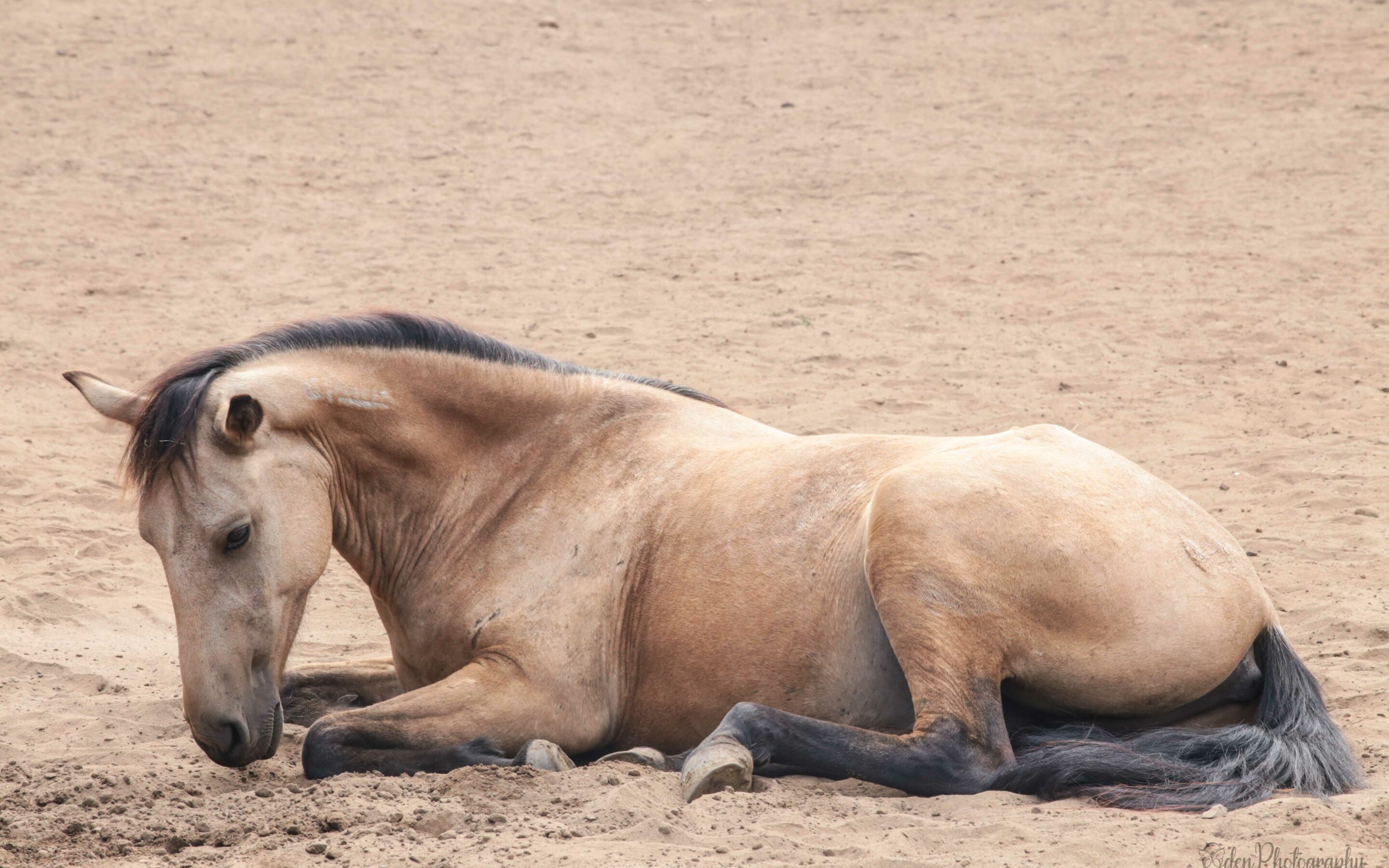
Otto’s Tummy-ache
I played a lot of horse games on the computer growing up, most of them focused on eventing (the act of jumping or a piaffe reduced to pressing a single button on the keyboard). While this was fine, my main interest was drawn to the care parts of the simulators — dragging a curry comb over the side of a homogeneously dirty pixelated horse and watching the dirt be wicked away in great rectangular swaths (it was the early 2000s, computer graphics were not focused on realism). In one game, you could not only brush your horse, but scoop grain for them as well, preparing a bucket to the specifications of a white board list: two scoops oats, one scoop bran.
Back then my knowledge was as rudimentary as the game’s graphics. Horses should be fed, watered, and brushed, but the nuances therein were not made clear to me until much later (and in all honesty, some still exist in blurry 8‑bit, waiting for further clarity).
This is a post about a recent colic that Otto had. I bring up these games because I wonder where “colic simulator” is. Press A to call the vet. Press B to remove hay. Here’s a mini game; listen for gut sounds, all 4 quadrants.
I’m not trying to make light of it – colic is never a fun situation, and can be ultimately tragic. Oh horses, why do your GI tracts have to work the way they do? But I’m thinking about how it would have been nice to have some kind of ingrained framework for what to do when the first signs appear.
When we talk about colic in our volunteer meetings, one of the most common questions is, ‘how will we know?’ I had the same question in the early days of my job, watching over each horse with the worried eye of a new mother, searching for anything even remotely out of place. There’s a laminated sheet of paper in our barn aisle, ‘signs of colic,’ listing out the common behaviors a colicing horse might exhibit: looking at their side, kicking at their stomach, rolling. But sometimes when there are flies buzzing around, or a sudden itch, there could be a stamp or a bite that seems unprovoked. If you’re the anxious sort, it could be enough to make you question things.
But now, having experienced more than a few colics, my answer to the question of ‘how will we know?’ is simple: ‘you’ll know.’ There’s something so off about a colicing horse, it’s nearly impossible to miss.
For Otto, it began with lethargy earlier in the day. He’s a young horse, and despite his gentle disposition, he is altogether a lively guy. So a dullness in his eyes was the first sign, and I’d say perhaps the easiest to miss, especially if you’re not familiar with his personality or mannerisms.
But then, when volunteers went out to his paddock a little past feeding time, they caught him lying down. It is not atypical for horses to rest, but it is not normal for a horse to take a nap when there’s food in front of them. The warning bells were ringing, and we swiftly took action.
We always call our vets at the first signs of colic, typically immediately after taking vitals to better inform them about the situation. Some colics are worse than others, and the conversation to the vet is less of ‘how should we proceed’ and more ‘when can you get here.’ Luckily, Otto’s was more of the former, with just traces of the latter.
Otto’s vitals were mostly normal, though his gut sounds were decreased. A heart rate within normal range told us he was likely not in a massive amount of pain, and he was not running a fever.
We led Otto out of his paddock to better monitor him inside. On his way into the barn, he had a very loose pile of manure. Passing manure, good. That manure being only liquid, not as good. He also was attempting to roll as we walked through the sand arena, another tell-tale sign. Our vets have said it is OK to allow a colicing horse to lie quietly, but generally speaking if they are trying to roll repeatedly, it is better to keep them up and moving. And so we walked Otto around as we waited for the vet to arrive – the information we had given her about him was enough for her to want to check him out in person.
Other signs of colic, in case what I’ve mentioned hasn’t already made it clear: Otto was pawing. Kicking a hind leg up towards his belly. Looking repeatedly at his side as if answering the question ‘show me where it hurts.’ He was reluctant to move, standing parked out, generally looking very uncomfortable.
“How do you know?” people ask. You’ll know.
Our vet arrived, and we all breathed a sigh to know relief was likely in Otto’s future. Dr Lewis gave Otto an IV dose of banamine, and sedated him to perform a rectal exam. Upon examination, Dr Lewis palpated an impaction on Otto’s right side. It is apparently not very common horses get impactions on their rights – what can sometimes happen is that an impaction on the left can get large enough that it migrates over, but given that Otto did not seem to have a very high pain level as evidenced by his vitals, Dr Lewis did not feel this was the case.
Otto’s rectal exam also revealed a crucial piece of the puzzle – the manure that Dr Lewis extracted had a good deal of sand mixed in with it.
The first step in dealing with Otto’s impaction would be to hydrate him with the hope he could pass it on his own. The word ‘surgery’ fluttered in the back of our minds, but we kept our fingers crossed it would not come to that. Dr Lewis intubated Otto, and gave him a fluid cocktail of electrolytes for rehydration, and epsom salts and mineral oil to act as a laxative.
By now, it was early evening. Dr Lewis penciled us in for first thing in the morning to come and check on our sweet boy, but told us to call if anything happened in the meantime. Our fingers remained crossed for a quiet night. We set Otto up in a stall with a camera so we could monitor him overnight, and offered him sweet water after sweet water to try and get as much liquid into him as we could. He did a very good job of drinking, which made us all feel a little better.
Our vets will also often suggest we move the horse out in intervals every few hours to help get their system moving. There is something mildly heartbreaking about making a horse with a stomach ache trot around for 10 minutes, but the feel-bads are quickly replaced by relief with each offering of manure or gas they produce. Never have I been happier to see a horse poop than when they’re colicing.
Otto’s mostly liquid stool was also explained by the impaction – his body was trying to pass, but there was a blockage in the way preventing much solid from leaving.
Overnight, we checked the cameras on the hour to monitor our sweet Otto, and moved him out several times to the tune of several small, mostly liquid piles of manure. But overall he did well through the night, and when Dr Lewis returned at 7am the next morning, we were all delighted to hear that the impaction had decreased in size, clearly breaking down. Otto got more banamine, more fluids, as well as a slow return to food – a senior grain soup. Fluids, fluids, fluids for little Otto, and luckily he is a very good boy who is not picky about the consistency of what he eats. He was very excited to have something to snack on, yet another sign he was perking up.
We ran a sand test on Otto, and found a staggering 1 ¼’ of sand in his sample. Along with his re-feeding schedule, Dr Lewis gave us a hefty psyllium fiber (sand rid) regime for Otto to follow for the next few weeks. Take 16oz and call us in the morning.
Going forward, Otto will get a monthly course of psyllium to keep him hopefully sand-free. This colic situation also made us consider what was going on in the guts of our entire herd. Dr Lewis told us that sand can sit in the gut for a long time, so even if we are seeing clear sand tests, it doesn’t necessarily mean sand is not present or will not appear down the road. Otto’s colic made us decide to treat our entire herd with psyllium quarterly to hopefully mitigate the risk of situations like this arising in the future.
And as far as sweet Otto is concerned, he is doing fantastic. As the days following his colic went on, he continued to perk up, eagerly awaiting his soupy mash mealtimes and calling out for his friends. We had separated him to keep an eye on his manure (the consistency of which also continued to improve), and it was clear he was eager to return. After a slow and careful reintroduction of hay, Otto was cleared to go back out with his buddies, and the four of them enjoyed a sweet reunion. Otto’s sand tests have since run clear, and he has returned to his regularly scheduled programming.
While it is tremendously stressful in the moment, these types of situations are great teaching opportunities that lead to the development of best practices that are potentially life-saving for our herd. Especially in a case like this, where everything worked out in the end.
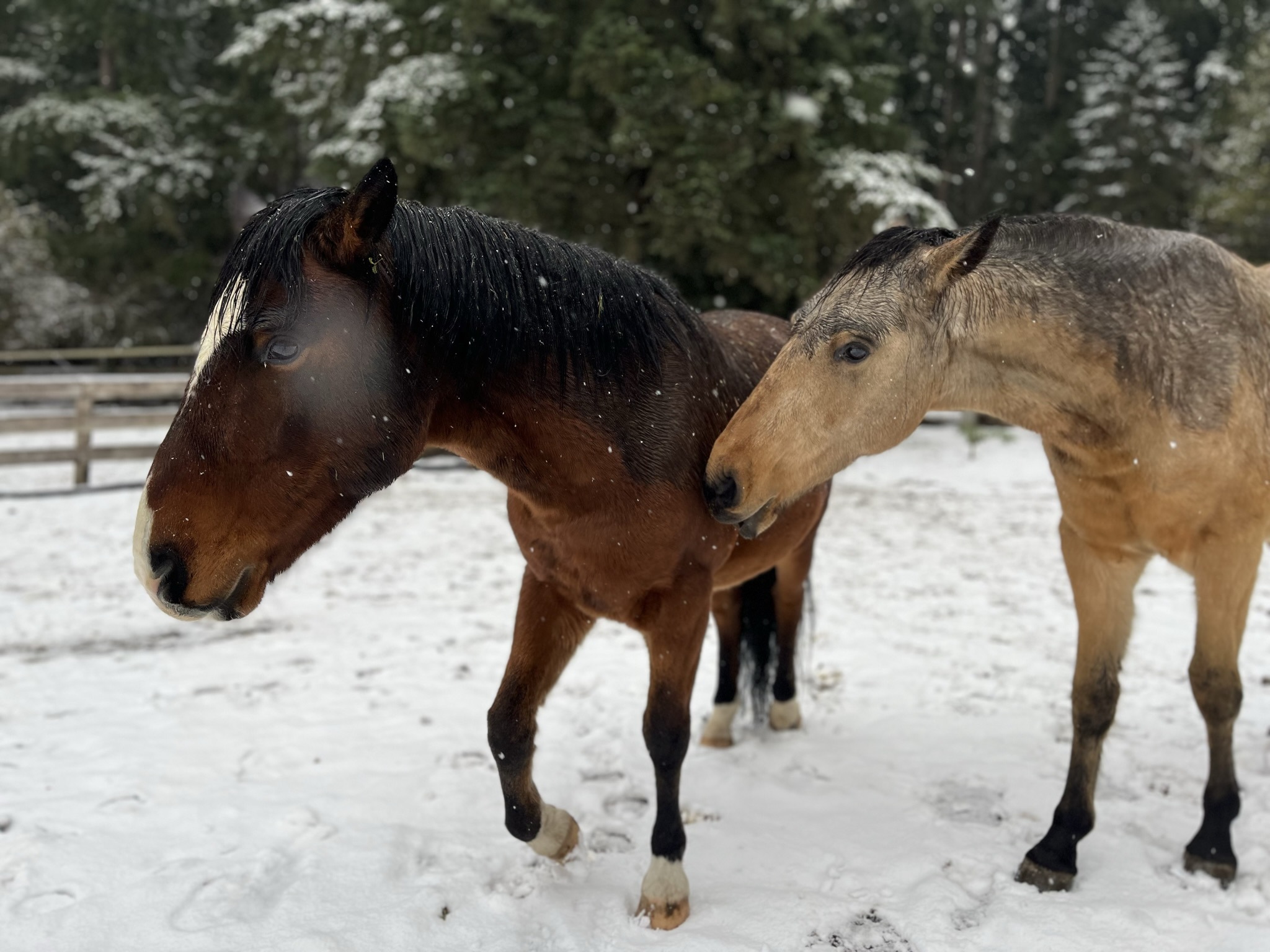
Otto’s Playmate
Though one might say he is mature for his age, based on how well he is going under saddle and his general level-headedness, the fact remains that Otto is still just a young lad, not yet 4. And boys, as they say, will be boys. Otto has been getting into some shenanigans as of late, with none other than his herd mate, Artie.
After they get turned out for breakfast and eat said breakfast (typically, Otto and Cramer share a net, as they have done since they were reunited earlier this year), it is play time. It doesn’t matter what Artie was doing before, or what his plans for the day were, because now, says Otto, it’s time to play. Playing, as it turns out, is a full time job, a real 9–5 activity. Every time you turn your eyes to the paddock where these two live during the day, it’s WWE.
And I say WWE because of its notoriously staged and scripted nature. The fighting that Otto and Artie do is (mostly) all bark and no bite. The majority of the time, it consists of Otto engaged in a slow-mo chase with Artie, nipping at various parts of him, until Artie gets fed up and nips back. Then the two titans clash – sometimes on two legs! – before engaging in a slightly faster chase sequence, separating for a moment, and starting the whole process over again.
While Otto might try to start something with Cramer on occasion, Artie is his go-to sparring partner on the daily. There is no limit to the amount of gelding mouth games they can play in an afternoon, and I’m convinced the only thing keeping them from going at it all night is the fact they come into separate stalls.
So far, any injuries they might deal to one another are minimal (“Tis but a scratch”), and we are sure to monitor their play for any hints of escalation. But for now, the boys seem happy to spend their days goofing around, bein’ boys, bein’ horses.

Otto, ready to meet you!
His deep voice — befitting a horse double his stature, but one that really stays true to his overall theme, which is that size doesn’t matter all that much;
His intelligence. He’s wise beyond his years, and you really get a sense of how level-headed he is even in base interactions;
How adorable he is. Pictures can only do so much, you’ll have to see him in person to really get a sense of how handsome he is.
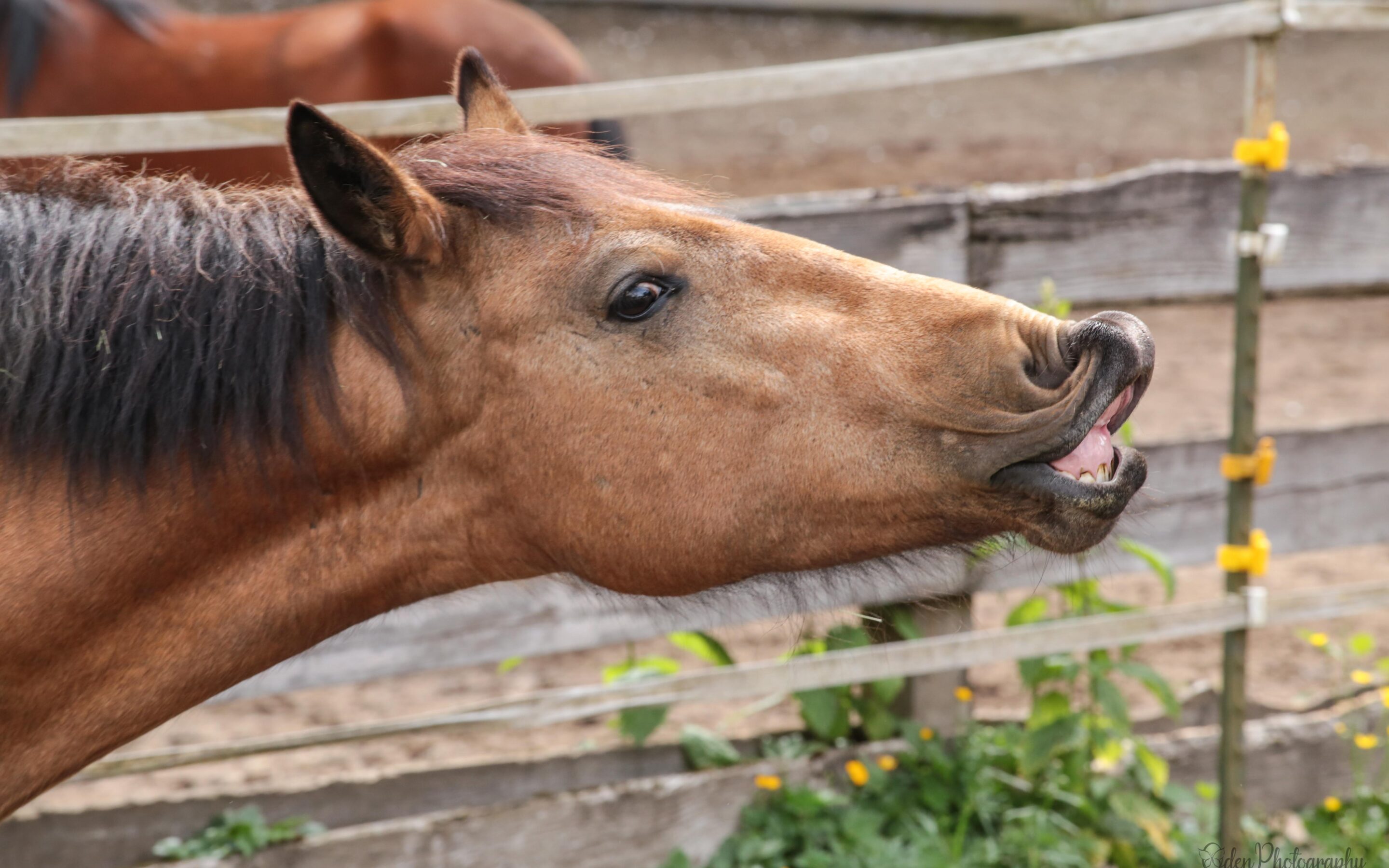
Otto Enjoying Summer
Sunshine, soft, fluffy dirt and playing with friends are the best reasons to lay down for a nap…everyday…several times a day. It’s usually the position Otto is in when our volunteer photographer visits the property. (Thanks Kristina!) He can’t be bothered to get up unless it’s to blow kisses.
Otto spends his days and evenings sharing a paddock with his bestest friend in the whole world, Cramer. Along with Montana, Artie and George. After sharing a morning hay box with Cramer, the five enjoy a little grass turnout time. A few times a week Otto is enrolled in groundwork training where he has now learned to carry a saddle!
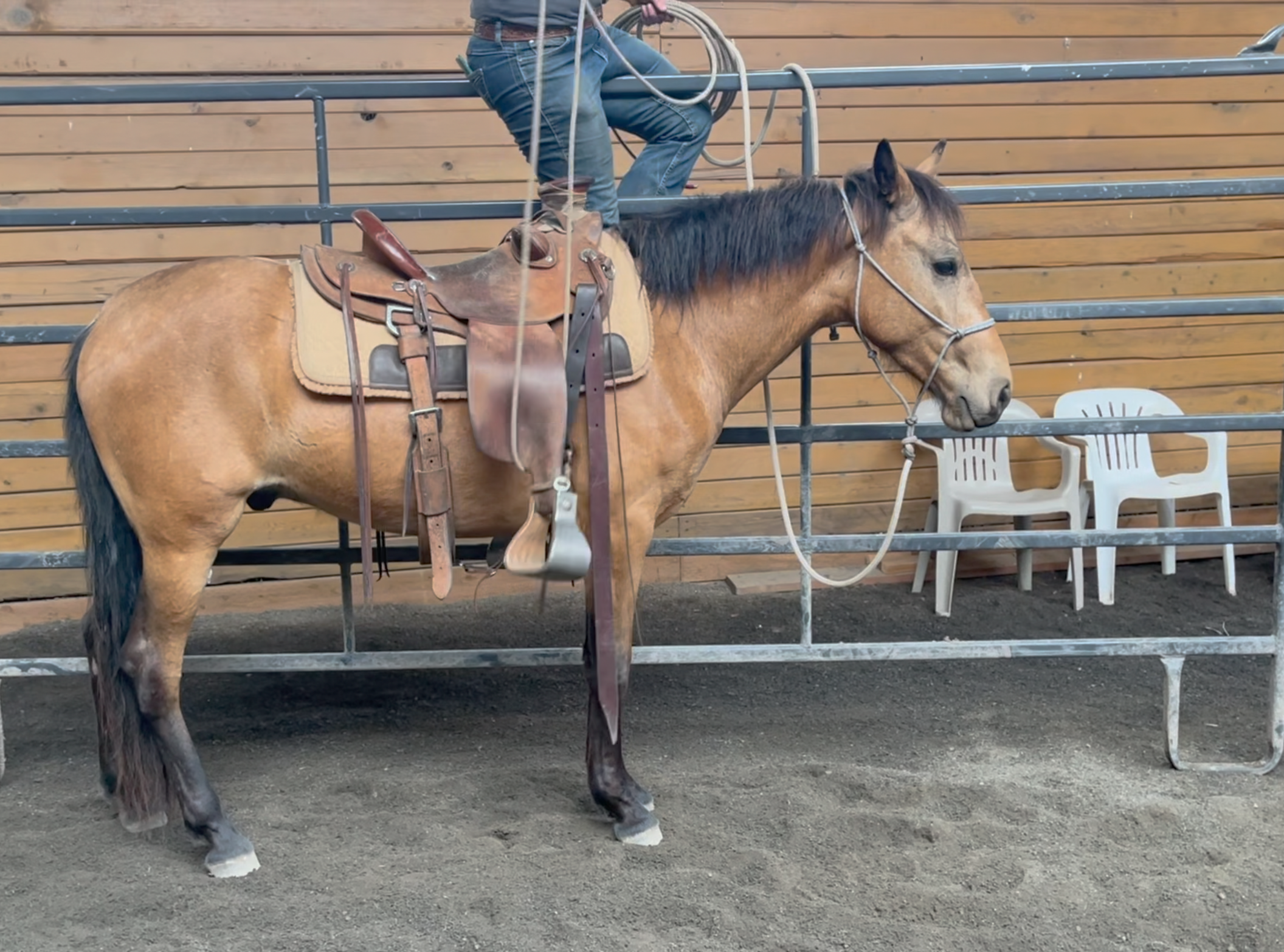
Training Update: Otto on the Fence
As part of a well-rounded education, our horses are put through paces that include more than just learning to wear a saddle. A class they must take and pass is learning to bump up to the rail. This serves several purposes, including but not limited to: learning to pick a rider up off the fence (not all of us can mount from the ground!), getting used to someone up above them, and learning to be ok with stimuli (like flags or a rope) in their blind spot. In the video below, you can see Otto on his way to ace the course.
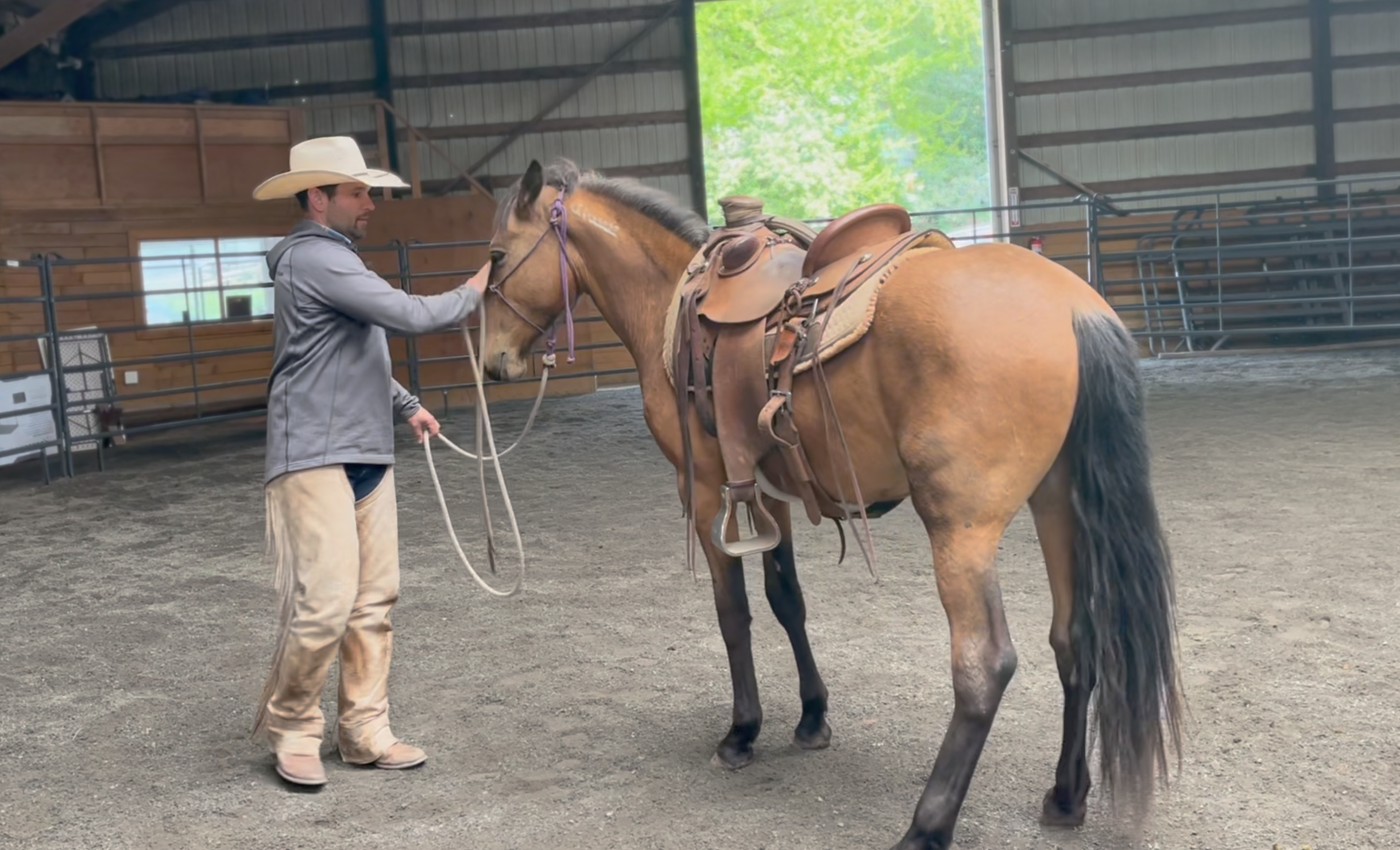
Otto Under Saddle
This month was the first time Otto saw a saddle (or rather, the first time he wore one – technically he’d probably seen one before then). First saddlings are always interesting. We do our best to prepare the horse before we cinch them up for the first time. Touching them all over with the flag, placing saddle pads on their backs, throwing the rope around their middles, all exercises to help simulate the types of things they will undergo when they wear a saddle. But even with the best preparation, the saddle is still a completely different experience. The saddle is constant pressure that the horse must learn to deal with – aided by support from us.
Many horses, when first saddled, will react to the first few (or even beyond the first few) saddlings. They are worried about the stirrups, about the various dangly bits on the saddle, about having something attached to their back. So we expected some reaction from Otto. But when that cinch was pulled snug, Otto just walked off, cool as a cucumber. Granted, he had the great support of Joel, but even still, his reaction (or lack thereof) was quite impressive. This was not a one off – Otto proved to be level headed with each subsequent saddling. The first time with a rider on his back he handled with the same mellowness. Not to say there weren’t still some spots where Otto got bothered, but overall, he was not reactive. This boy has a good (not to mention very cute!) head on his shoulders, and we are excited to continue our work with him.
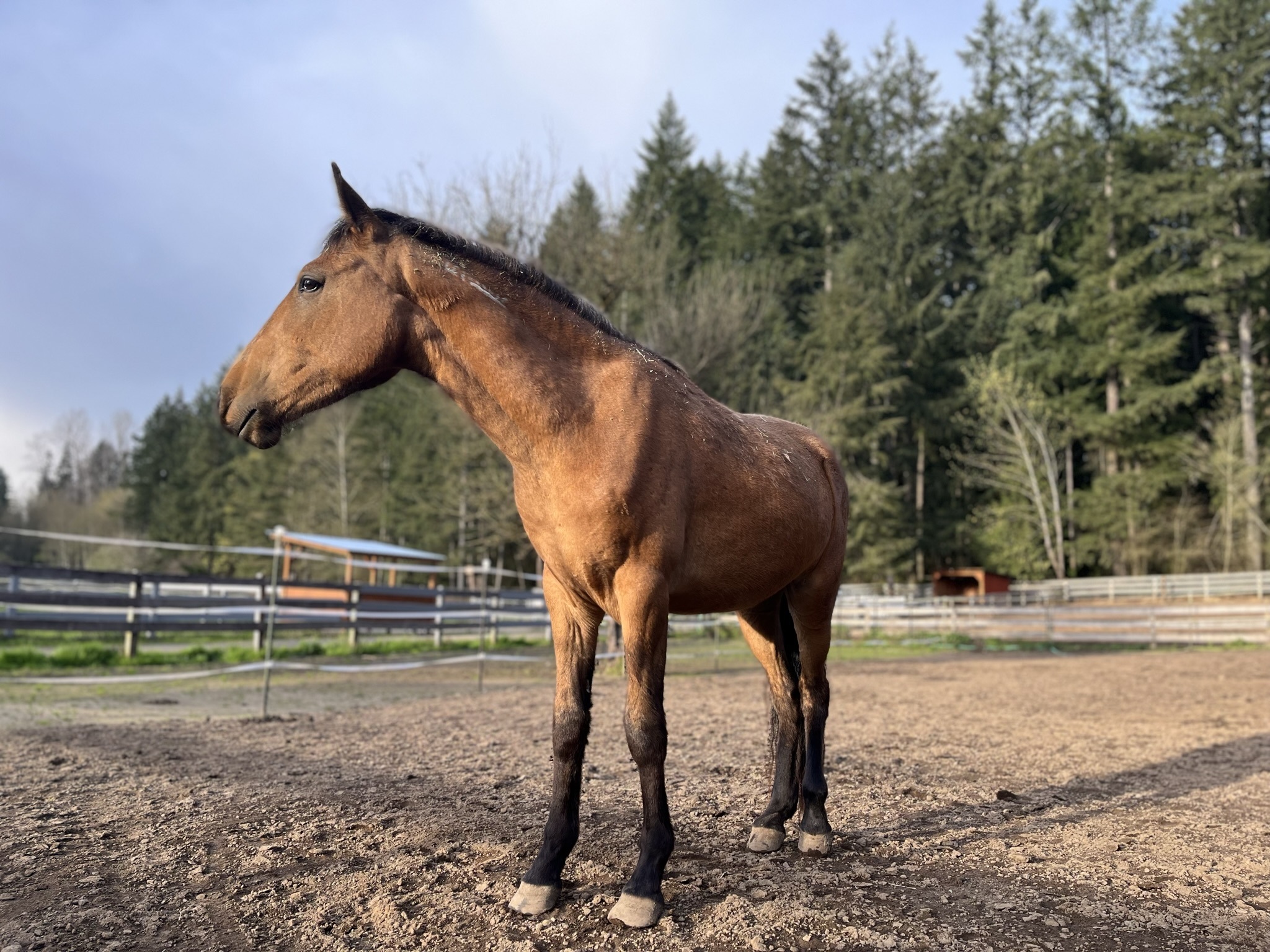
Otto’s Origins
Otto arrived at SAFE the very definition of a ragamuffin, with a scruffy, mud-caked winter coat draped atop his thin frame. We looked forward to seeing what health would do for Otto.
It brought out his personality, for starters. Even when on the mend from his tooth extraction, Otto remained a rambunctious and playful gelding. It also revealed some mysteries about his past.
During a vet visit, when Otto would be sedated to have his oral cavity repacked, we took the opportunity to microchip him (we try to coordinate microchipping with times when the horse is sedated for their comfort). Before chipping, we always scan to check that a chip does not already exist. Nine times out of ten, we find nothing. Otto was the exception.
It was quite shocking when the chip reader scanned a number in Otto’s neck, even more shocking given that Cramer, the counterpart he arrived with, was not chipped. So there was a mystery afoot.
As this was all happening, Otto had begun to shed his winter coat. His hair when clean was a light buckskin, which he was losing in great uneven swatches. But his undercoat was much darker, a caramel color, something akin to a perfectly toasted marshmallow. This shift in color was another unexpected surprise.
And then, one afternoon, a patch on his neck drew attention – there were white hairs peeking through his patchy fuzz. “Could it be?” we asked, and it was:
A brand. Given by the BLM. Which explained where the microchip came from. With a pair of clippers, we further excavated the symbols that would give us an idea of who Otto was before he was Otto.
We discovered he was from Nevada, from a herd management area called Red Rock, around 20 miles west of Las Vegas. With the assistance of the BLM and a very helpful woman who lives in the area and documents the wildlife there, we were able to obtain information about Otto’s past, as well as some photographs!
- Otto with his BLM number tag
- Little Otto and his dam
Born in March of 2019, Otto was rounded up in February 2020 as part of the Sacramento TIP challenge. This is the same time that Otto and Frosting came to know one another, as they were adopted together. Once thought to be siblings, we have since determined that the two were merely thought to be such due to their similar appearance and origins.
At only three, Otto has already traveled more than some horses (or people, for that matter) do in their entire lives. But we are oh so glad that this little desert-born boy found his way to us. His past may still hold mysteries, but we are excited to be able to set up his future to be as clear and bright as possible.
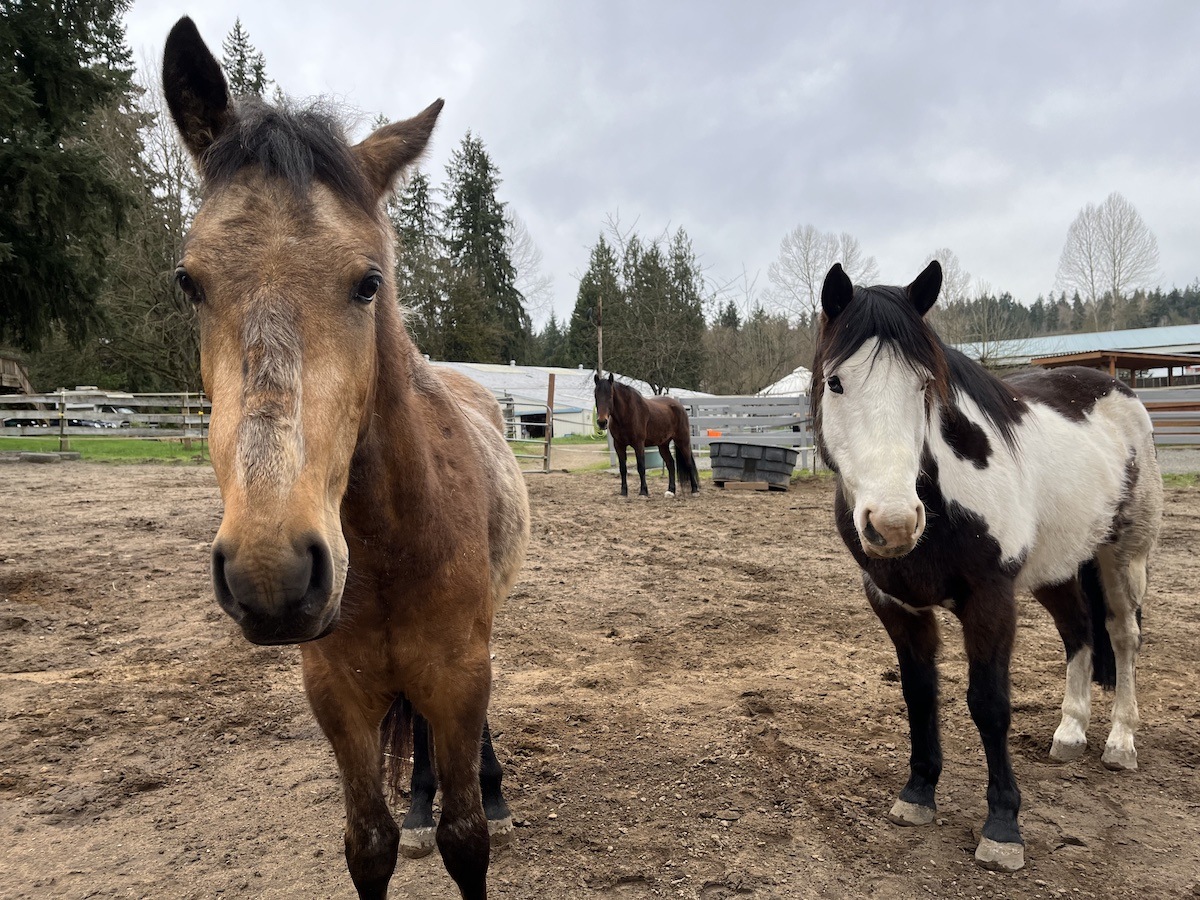
Two Men and A Baby
I’ll admit, the title is a bit misleading. But to see new herd-mates Nyx, Montana, and Otto out together, I think it would quickly become apparent to anyone who are the men and who is the baby. A brief description of the herd has –
Nyx starring as the benevolent leader of the pack, a gentle giant not only in appearance but also in mannerisms. His signature display of dominance involves floating a hind leg up in warning, rarely if ever following through with a half-hearted kick that never lands.
Montana cast as a (mostly) stoic member of the band who often spends his time sidled up to the fence line that adjoins the filly’s paddock. He has been known to participate in a romp or two with Otto, but is just as comfortable lounging around with Nyx.
and
Otto, rising star. It is hard not to look at Otto and not be reminded of your little brother or mischievous younger cousin. Most of the time, Otto would rather run and play than eat breakfast – often he can be found nipping at Nyx’s heels or tail in an attempt to draw his large friend away from the food (it has not worked yet). When Nyx won’t play, Otto tries his luck with Montana, and often is able to rouse a bit more interest from his paint companion.
These three boys were fast friends, and it’s clear that they really enjoy each other’s company. Often, all three can be spotted eating from the same hay net (Nyx and Montana usually work on the net itself, while Otto finds vacuuming up the fallen scraps to be more his speed), and they have been known to take communal naps together on occasion. It is truly a pleasure to watch the three of them, as their personalities mesh so well together despite being so different, and it’s clear that they all have something to learn from each other.
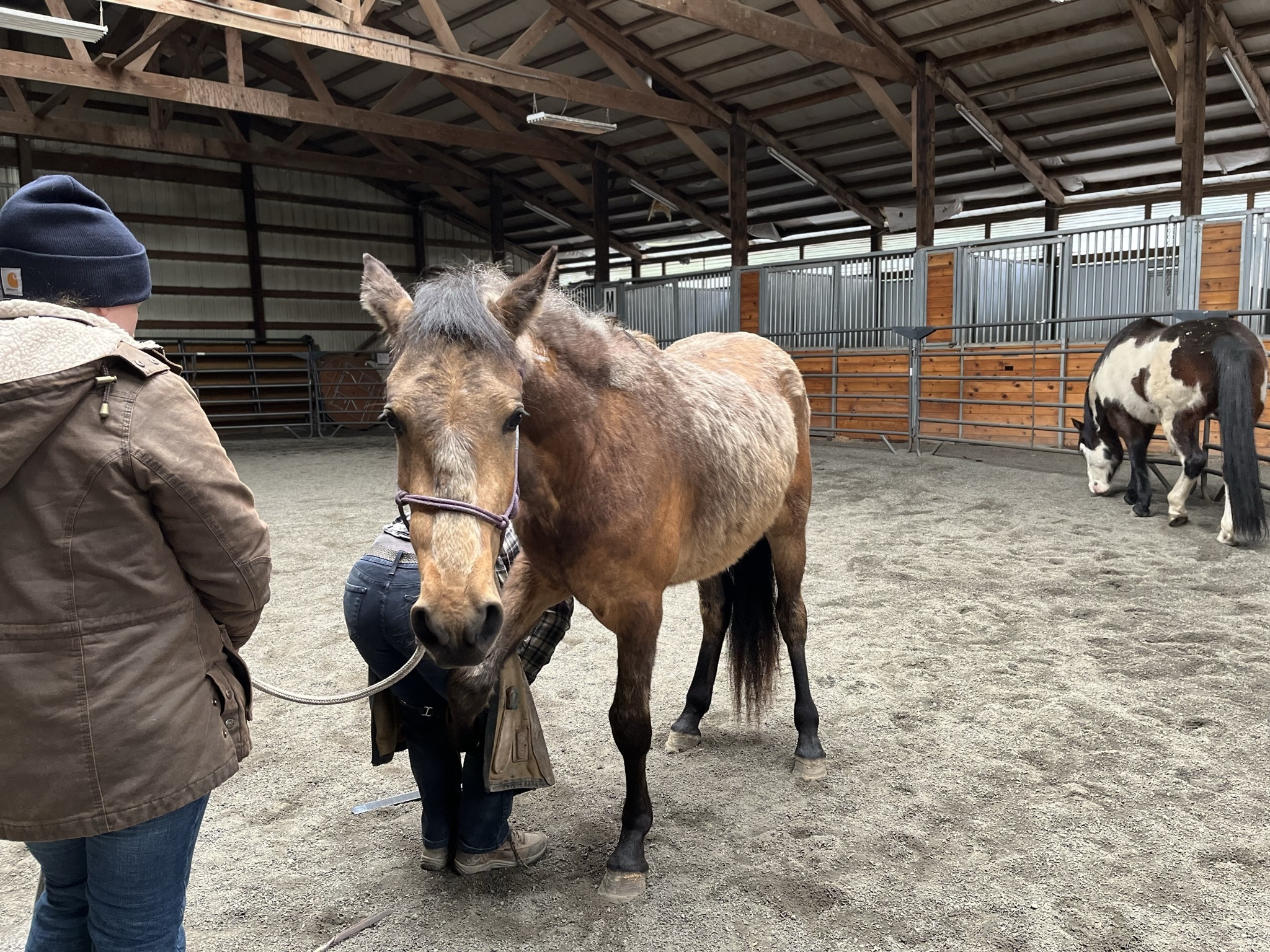
Trim Time for Otto
Last time our farrier was out, Otto successfully had all four of his feet trimmed. It is such a pleasure to watch this young man as he sheds out and grows up, the latter of which includes a vast difference between his first trim and this, his most recent one. Learning to stand and be patient for the farrier can be a big ask, especially when you’re not used to having your feet handled, but prep-work makes such a thing more and more manageable until eventually it becomes a non-issue. And when you’re a smart guy like Otto, that day seems to be arriving sooner rather than later.
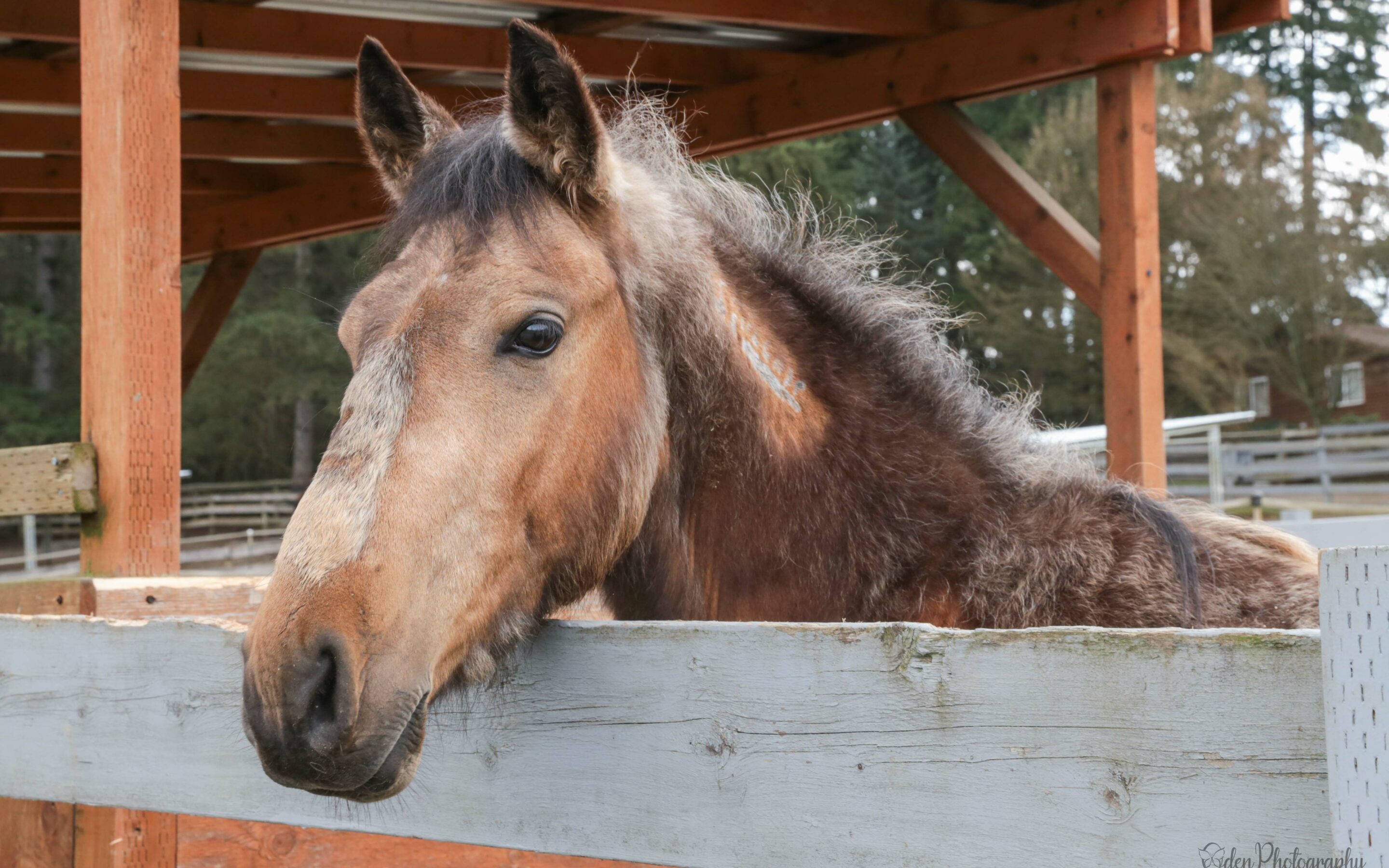
The Tooth Fairy Visits Otto
Though his follow-up appointment wasn’t for another month, a few days after he returned from his check-in with Dr. Hanson, Otto decided he was ready to go back. His now characteristic bump was appearing noticeably larger, and after a call to the vet, it was decided that it would be a good idea for him to be seen again. So back up to Mt. Vernon he went.
(A brief sidebar here: we are so grateful for volunteer and driving master Jackie L, who volunteered both times to trailer Otto the three hour round-trip to the vet.)
In Redmond, we waited for updates.
The tooth fairy was smiling down on Otto, for when Dr. Hanson called, it was with the news that he was able to successfully extract Otto’s infected tooth from the inside – the best possible scenario. It meant recovery would be much easier, since there was not a need to open a hole in the side of his face to extract the tooth. Otto spent a few days at the clinic while Dr. Hanson evaluated the best packing for his cavity. We scheduled weeks of follow-up visits with Dr. Renner at Rainland to re-pack the area and ensure the healing process was coming along smoothly.
Otto was seen three times for re-packs and checks, each time more healed than the last. He was to remain on the same course of antibiotics he was receiving until the cavity filled in at least 50% with granulation tissue. At his third check, Dr. Renner told us that the cavity was becoming more difficult to repack since it was closing up. Because of this, there was a good chance that the packing would not stay in as it once did, which would leave the cavity open to getting hay stuck in it. As this would inhibit his healing process, Otto temporarily switched to an all-senior grain diet – something he didn’t seem to mind at all!
At his latest check, Dr. Renner declared Otto all healed up! He was cleared to come off of the antibiotics, and was given the go ahead to start eating hay again. Going forward, Otto will need dental checks every 6 months to ensure that his other teeth are doing well as he continues to mature. And though it has gotten smaller, the bump on his face will probably remain in some capacity for the rest of his life – not only a reminder of what he overcame, but a perfect indicator of where best to place a kiss.
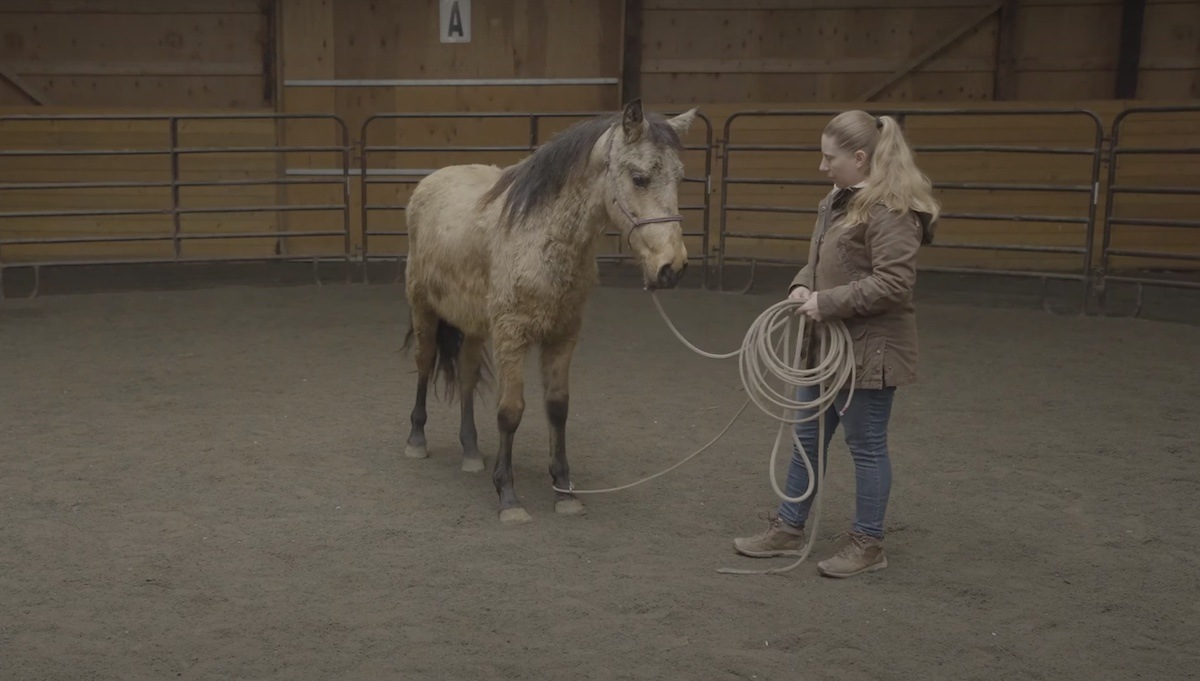
Otto Training Update: Giving to Pressure
Check out this video of a training session with Otto as he works on giving to pressure through the use of a rope:
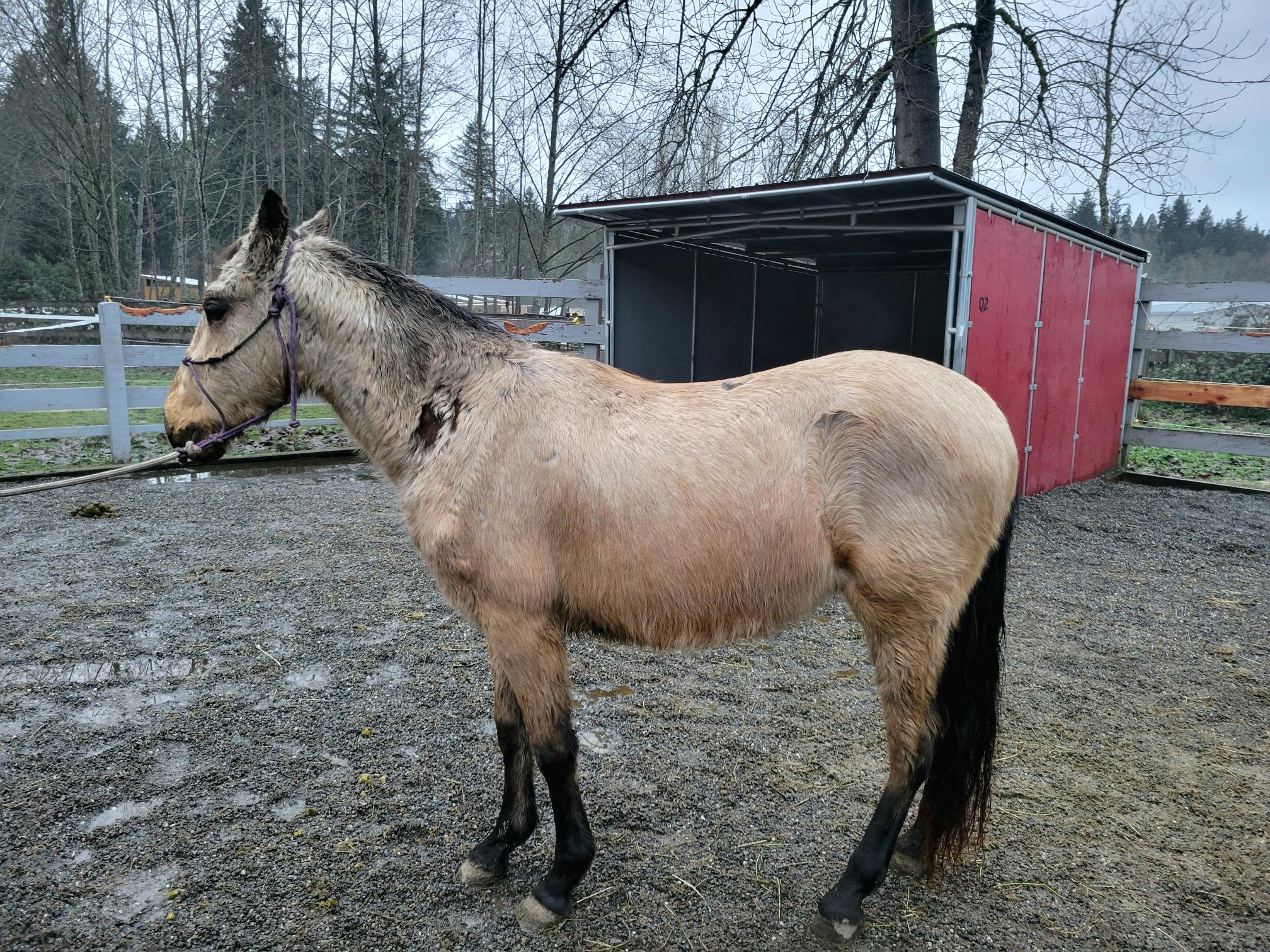
Update on Otto
This little cutie is feeling much better after packing on a few more pounds! He has proven to be fairly even mannered and willing to try what is asked of him. Pretty much ground ties like a champ for grooming sessions unless its food time and then all the attention is getting to his yummy hay! He was a bit of a stinker to pick up his hooves but that is getting better with constancy.
He had a dental recheck a few weeks ago to see when and how they can best manage the removal the broken teeth he had on arrival at SAFE and clean up the area damaged by the infection.
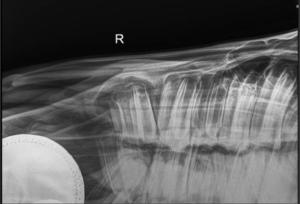
The white area bulging around the first tooth is the infected bone area. The white line running at the other end of the tooth is where the jaw bone ends and the tooth comes out through the gum line. You can see there is just a very small amount of tooth showing through the gum line at the time this image was taken. This is why it’s so difficult to get a hold of and we are waiting for it to erupt more through the gums.
Dr. Hanson evaluated Otto’s progress a few weeks ago. Some more teeth have ruptured and emerged out of the gum line. The ulcerations have all healed. The infected tooth still has not emerged enough to get a good handle on it for an in-mouth extraction. There is a tool that could screw into the tooth and help pull out but there is concern that the tooth may fall apart during this procedure. The third option is to open a hole on the side of his mouth and remove the tooth by pushing it from the top. The concern here is that these holes may not close up and there can be complications.
- Intake
- One month after intake
- Otto Intake
- One month after intake
- Intake
- One month
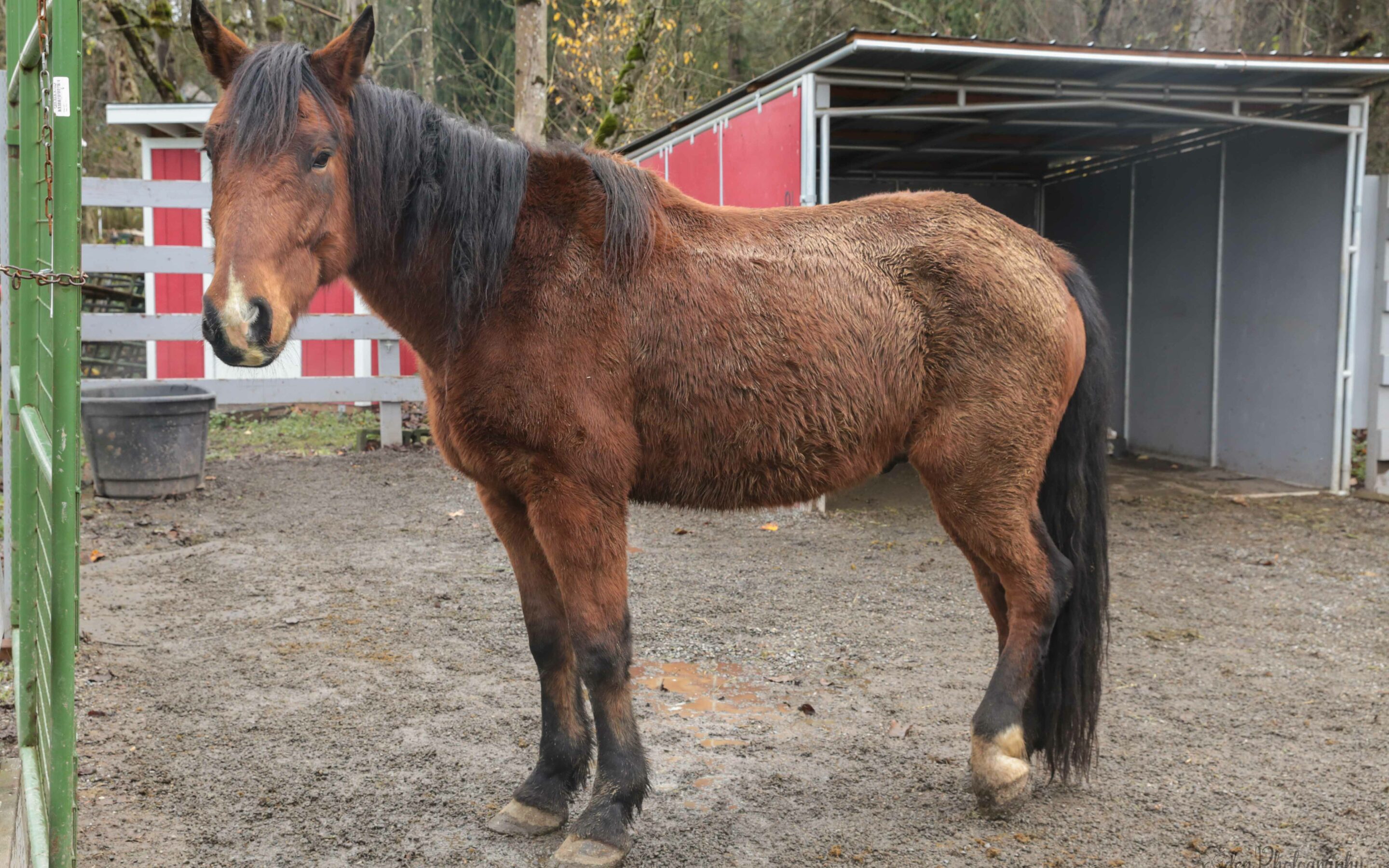
New Horses: Cramer and Otto
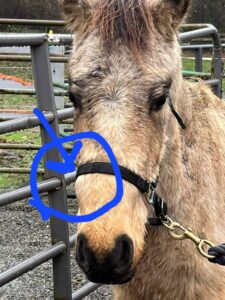 A few days later, Otto arrived. Cramer was excited to see his familiar face after being alone in our quarantine paddock. Otto is only 3 years old and is in need of a ton of groceries and will be on antibiotics twice a day for a dental infection. As you can see in the photos, there is a bump on his nose. This is the site of a broken tooth which happened when one of his adult teeth ruptured through and broke the baby tooth in place. Now, with infection making its way into the bone, this is a horrific situation. There was discharge from the right nostril, a foul odor, and could abscess through the sinus passage. The vet said this might be a good sign and help the surgeon. We are hopeful after putting on some pounds he will be strong enough to have surgery with the NW Veterinarian Clinic in Mount Vernon. This little man’s journey is just beginning, but he is in the right place now!
A few days later, Otto arrived. Cramer was excited to see his familiar face after being alone in our quarantine paddock. Otto is only 3 years old and is in need of a ton of groceries and will be on antibiotics twice a day for a dental infection. As you can see in the photos, there is a bump on his nose. This is the site of a broken tooth which happened when one of his adult teeth ruptured through and broke the baby tooth in place. Now, with infection making its way into the bone, this is a horrific situation. There was discharge from the right nostril, a foul odor, and could abscess through the sinus passage. The vet said this might be a good sign and help the surgeon. We are hopeful after putting on some pounds he will be strong enough to have surgery with the NW Veterinarian Clinic in Mount Vernon. This little man’s journey is just beginning, but he is in the right place now!- Otto Intake
- Cramer

